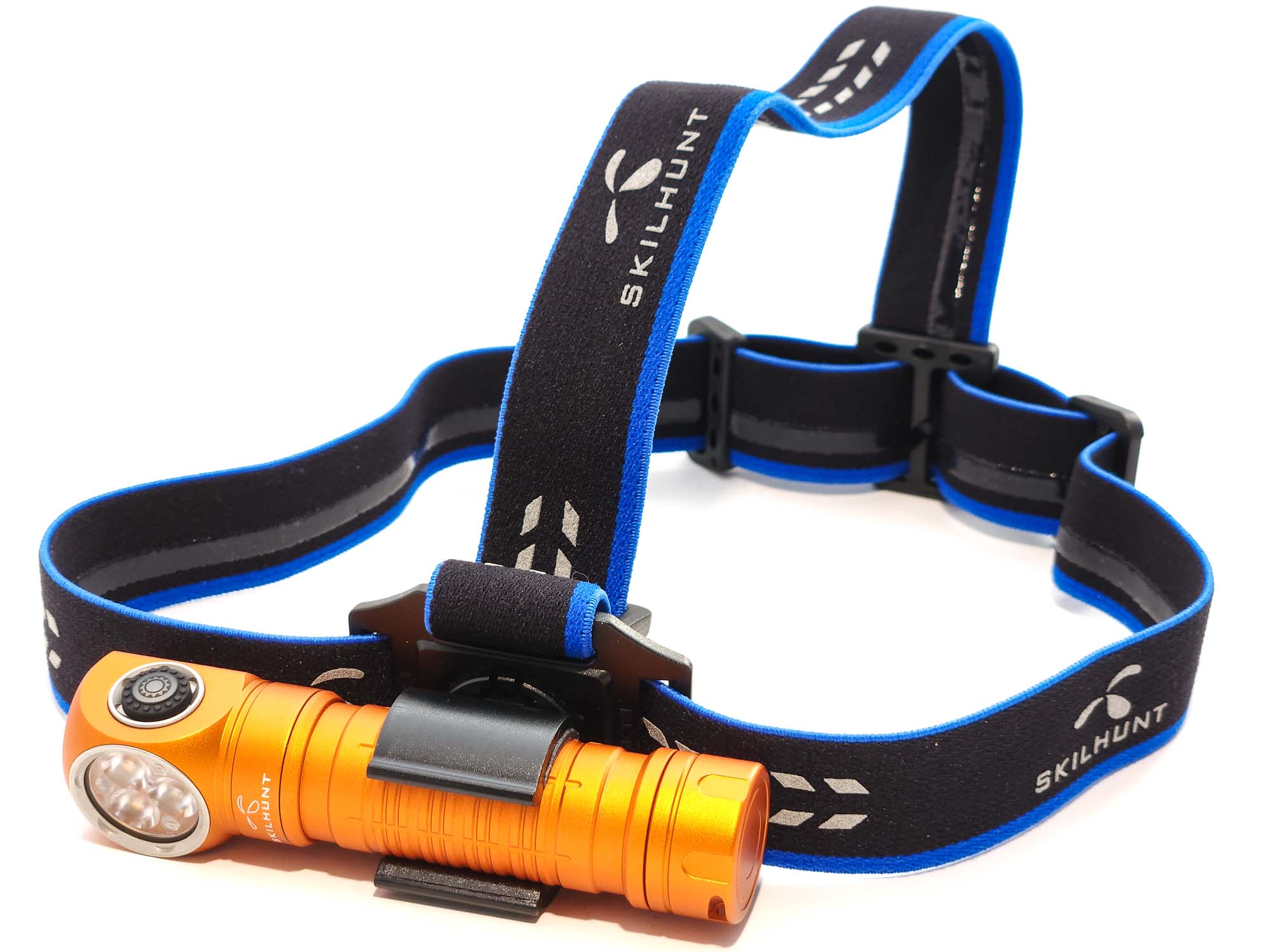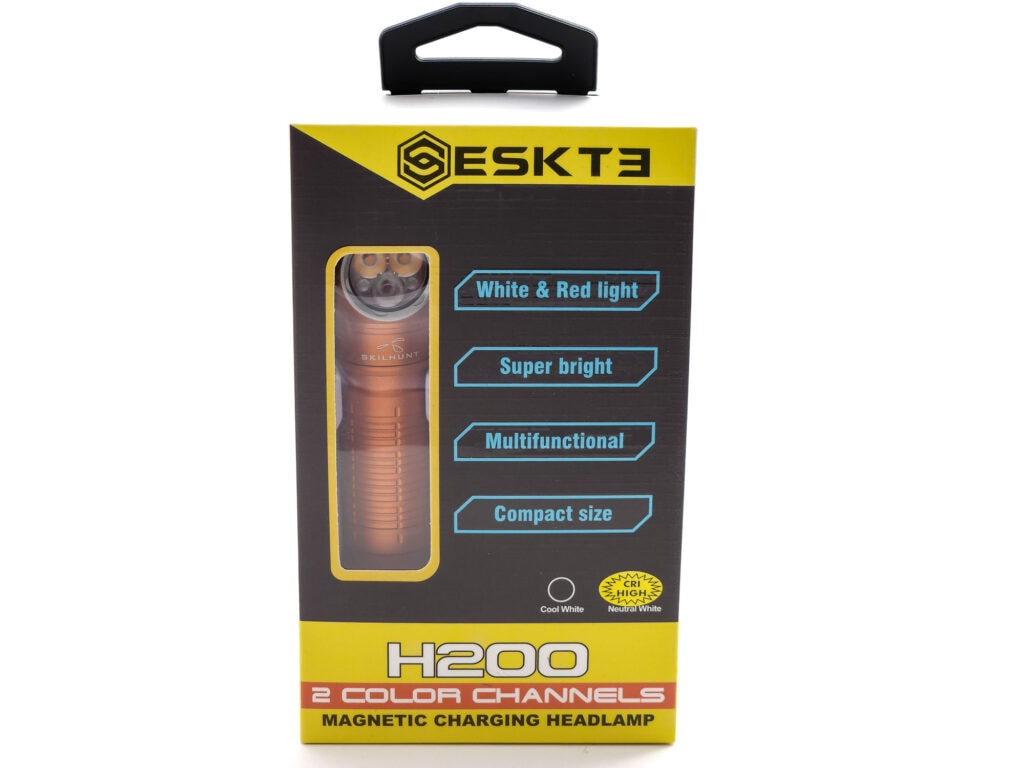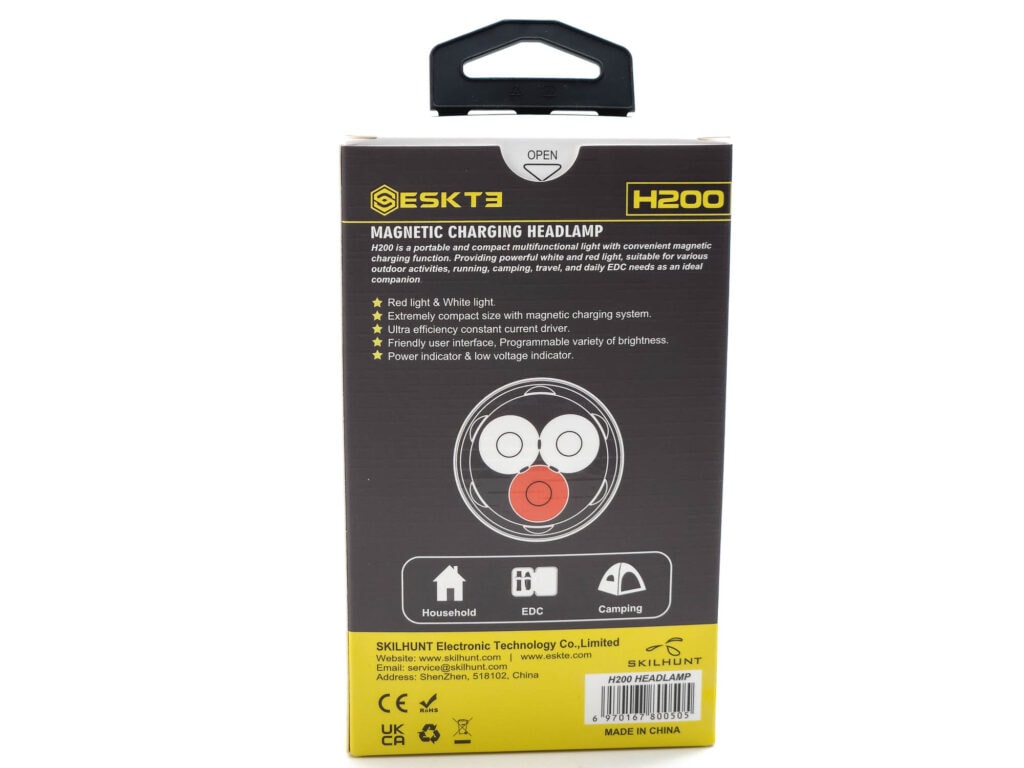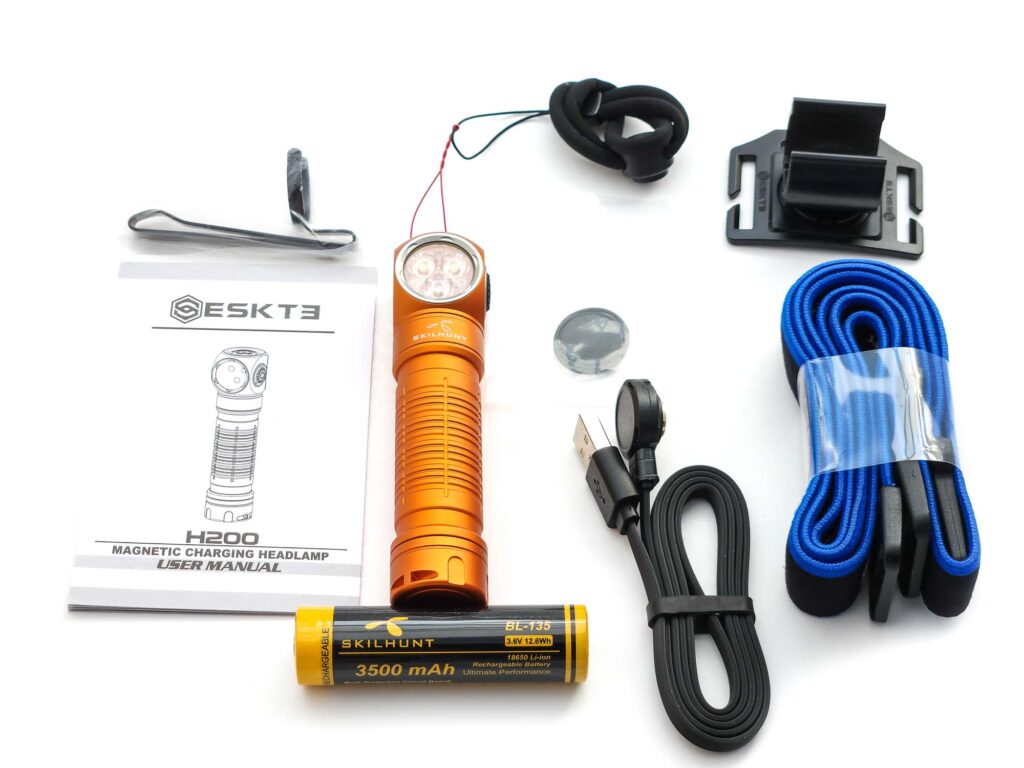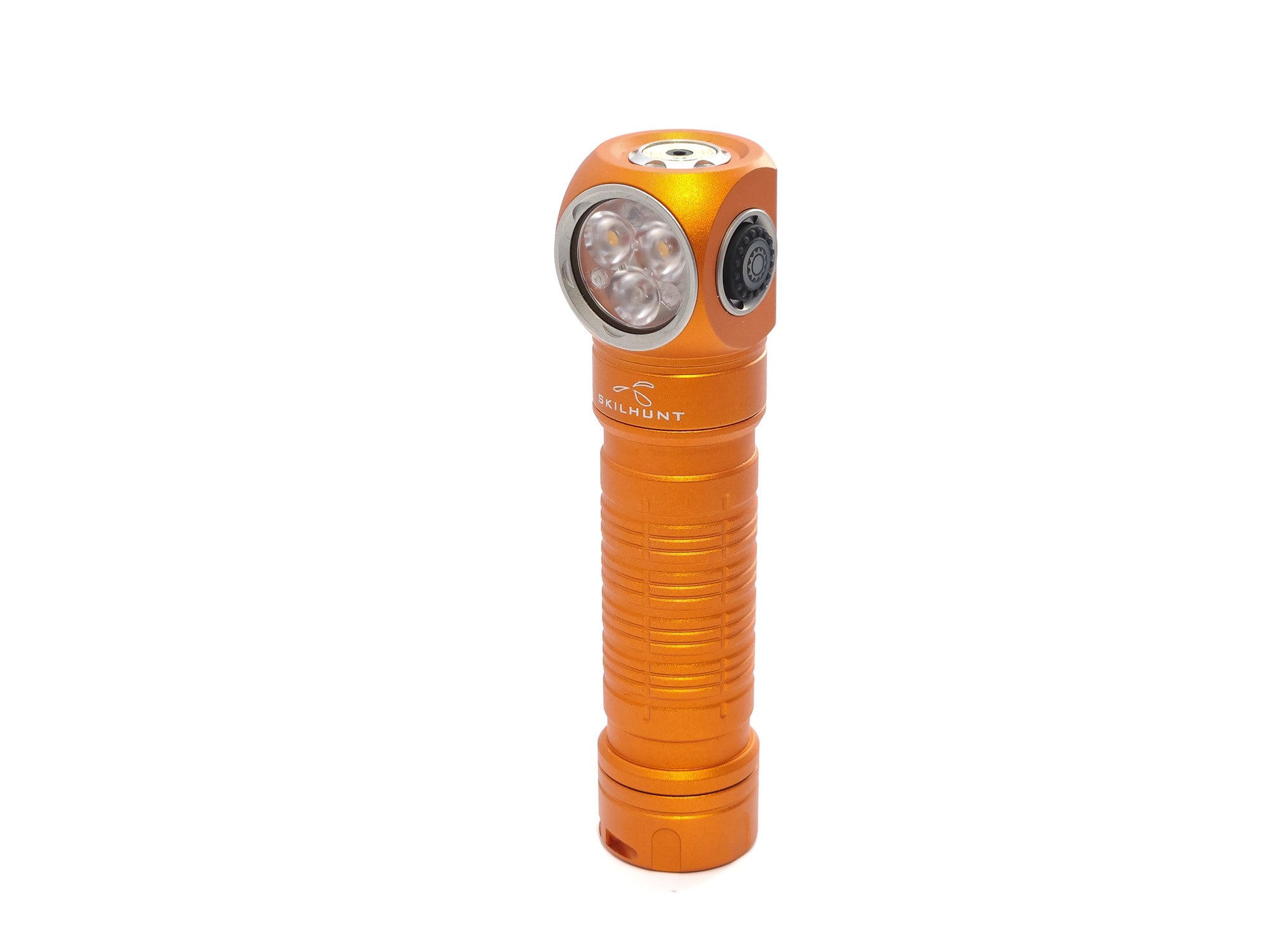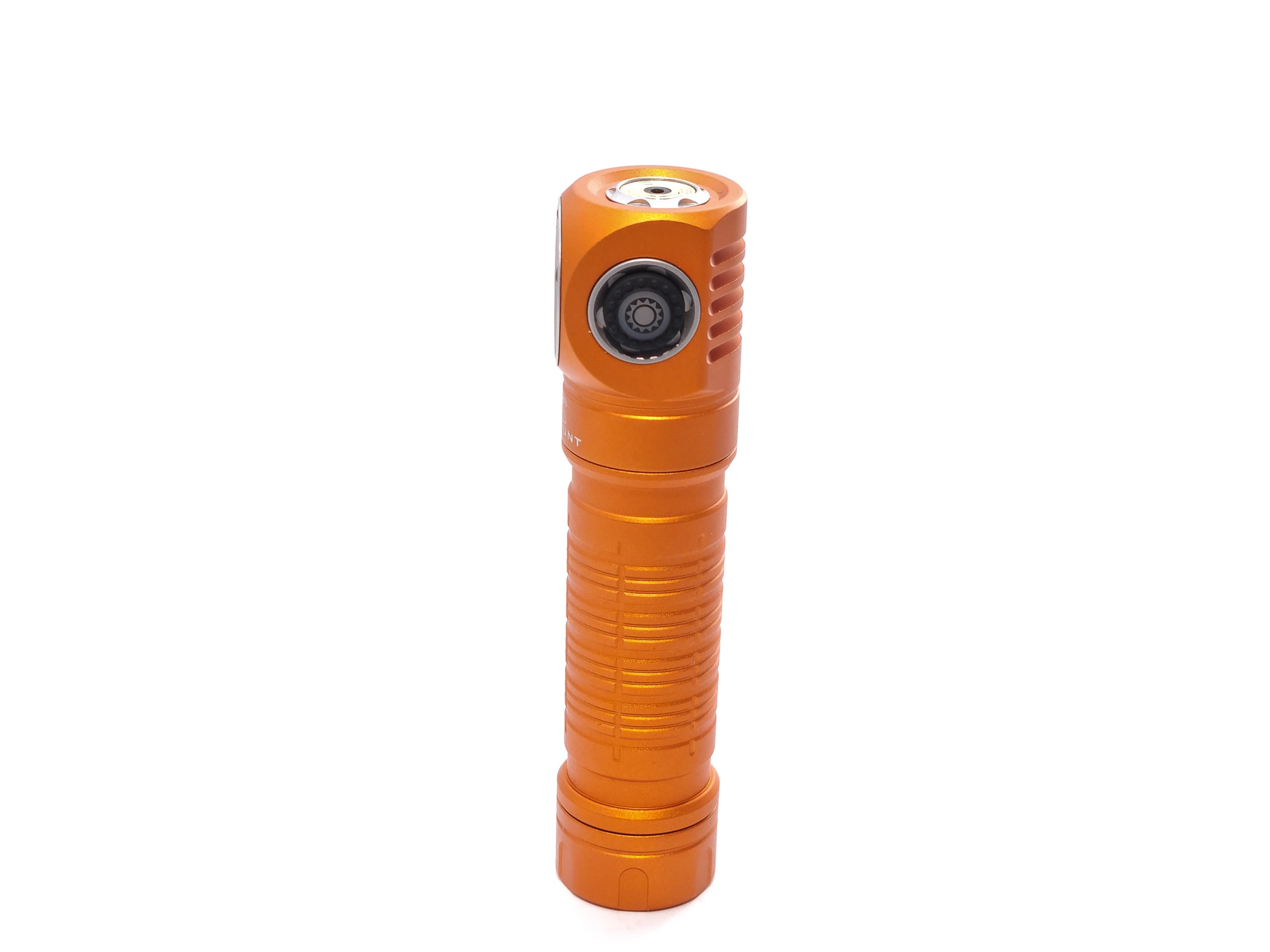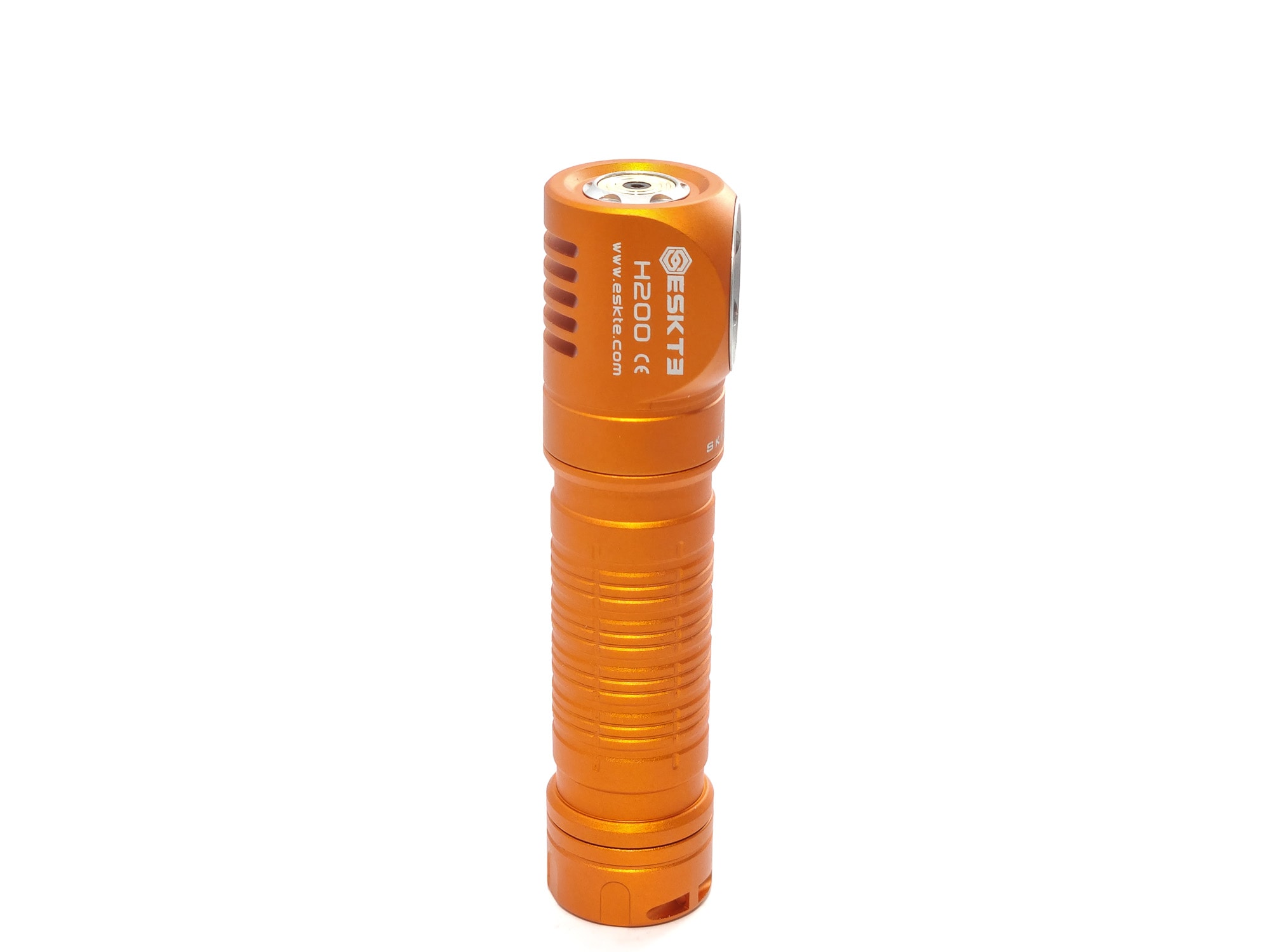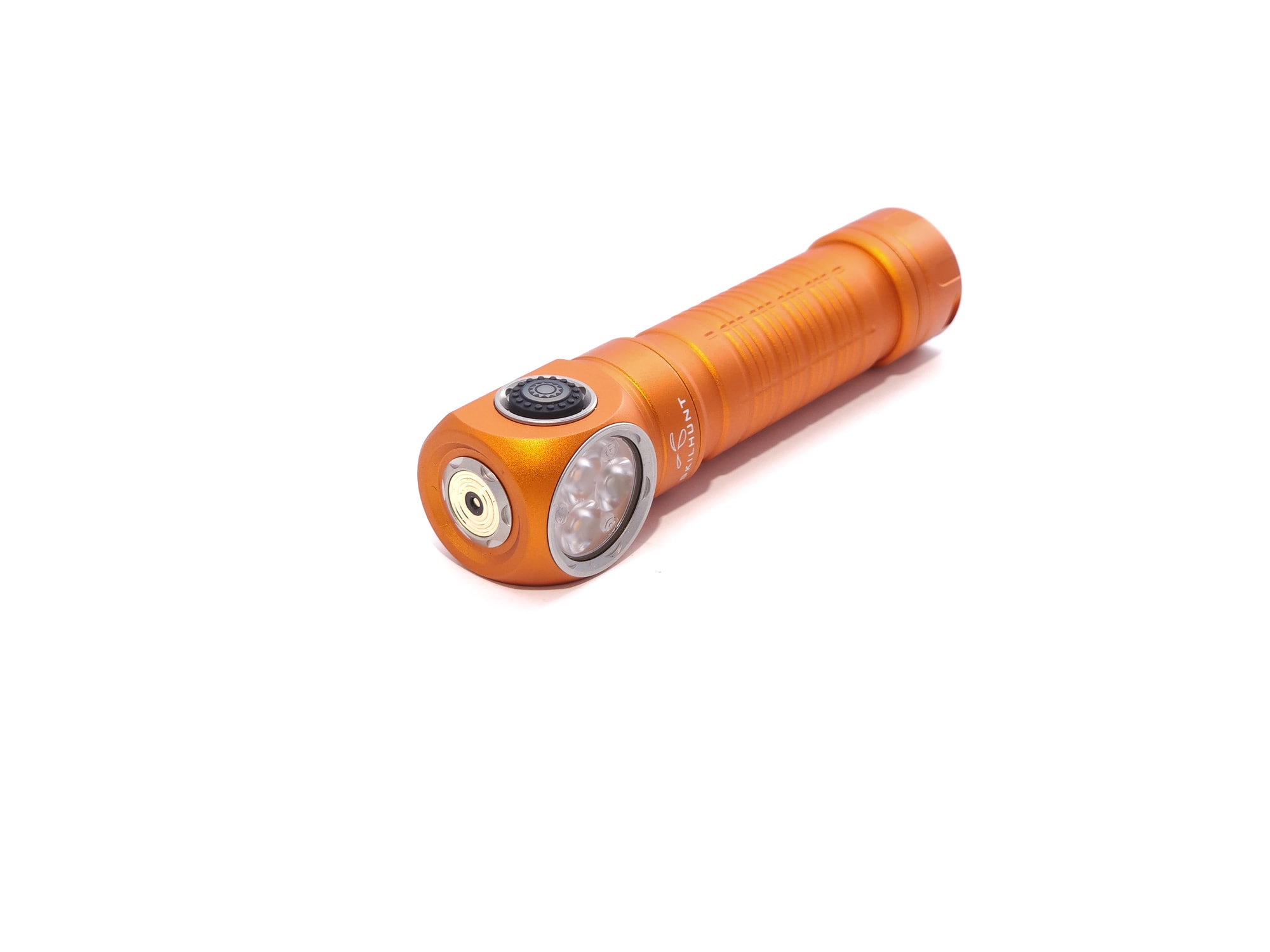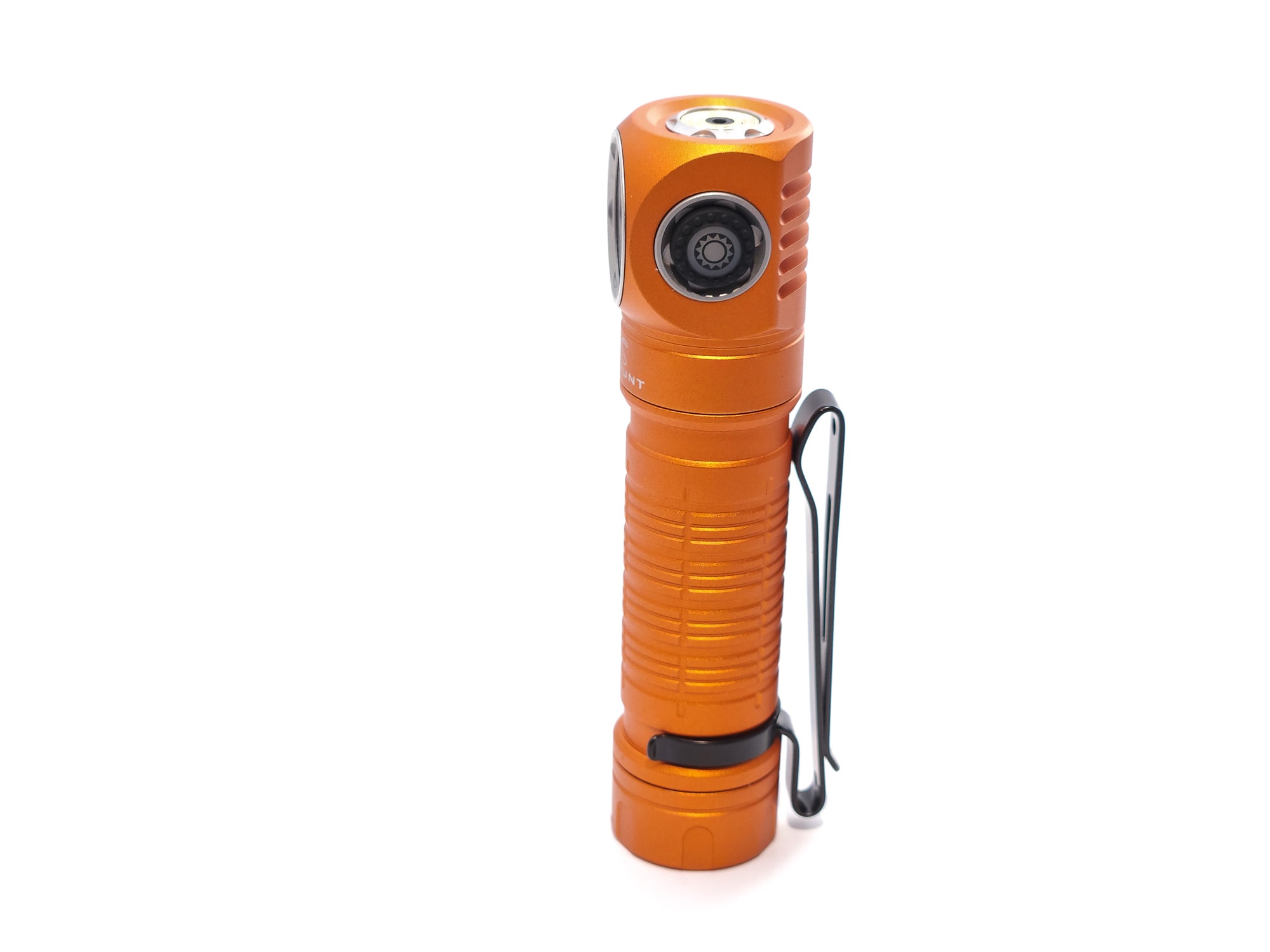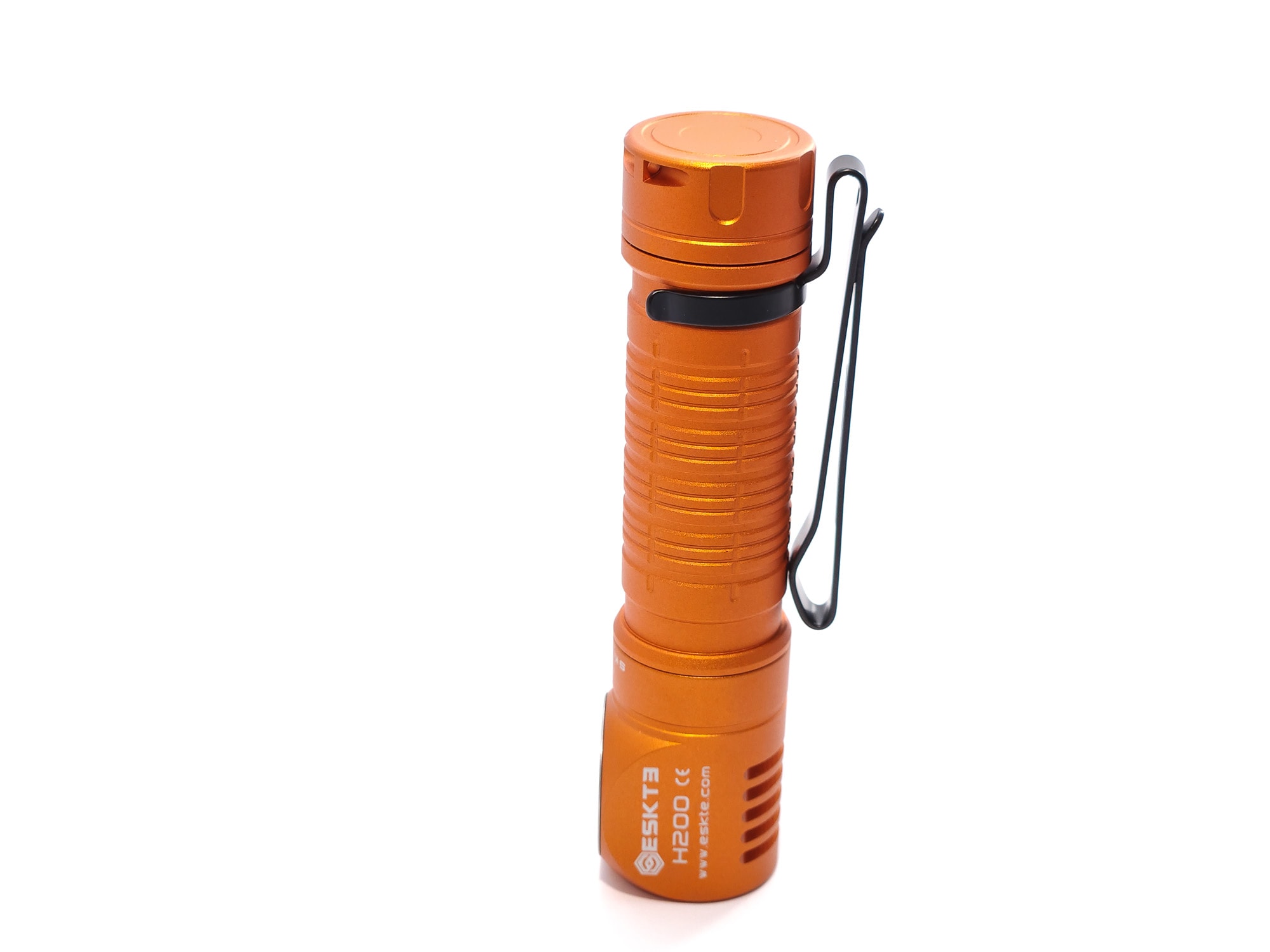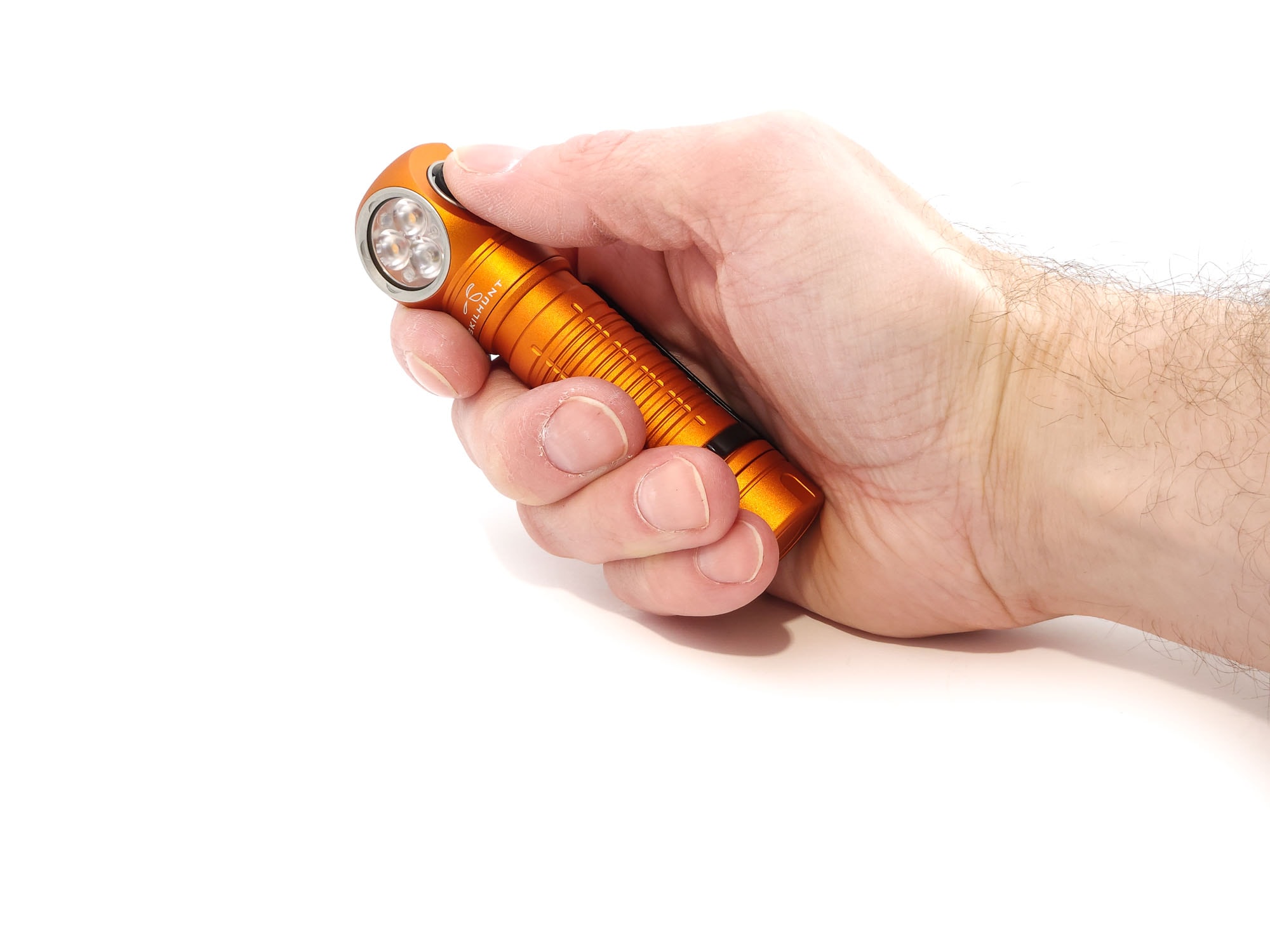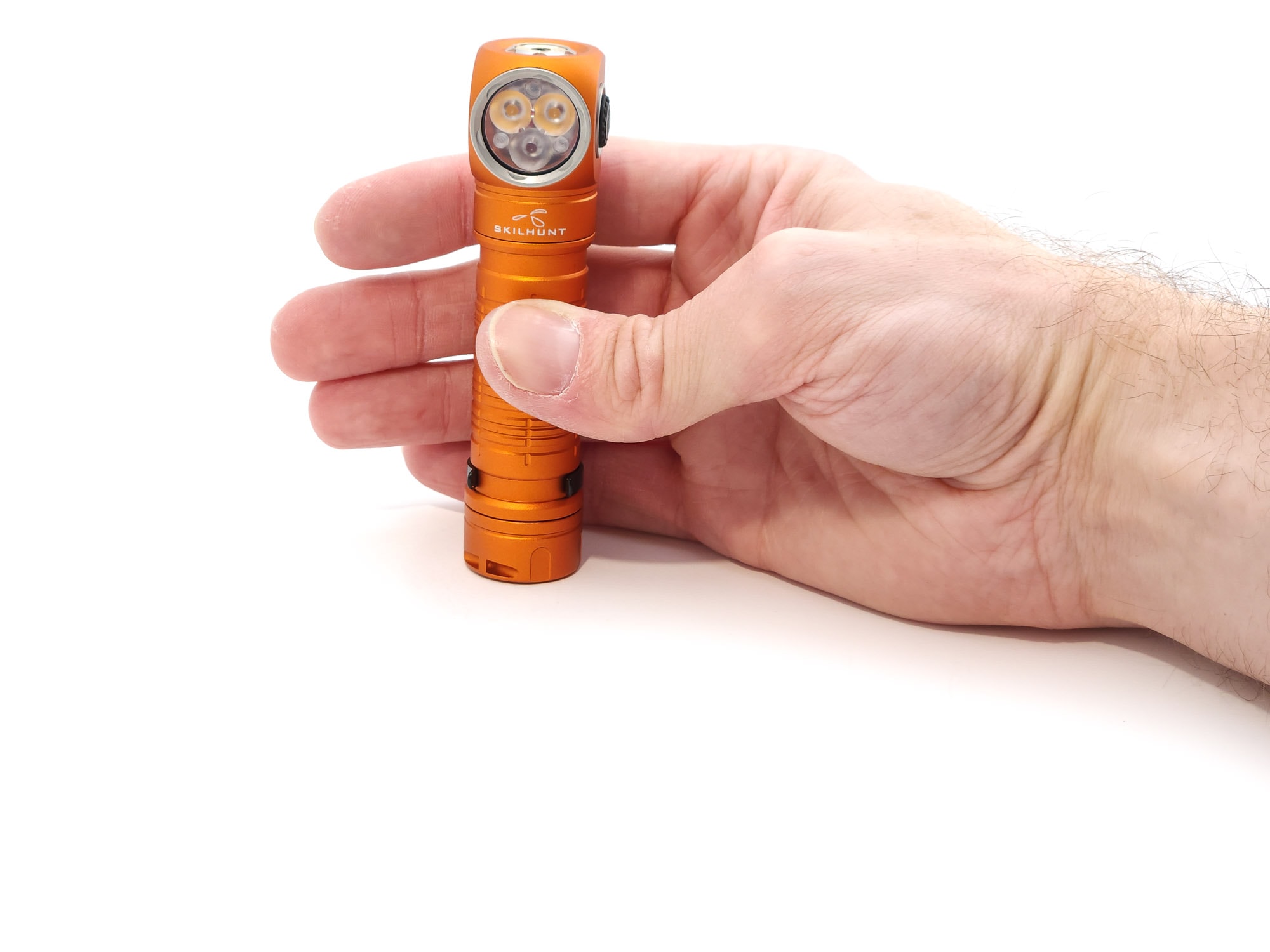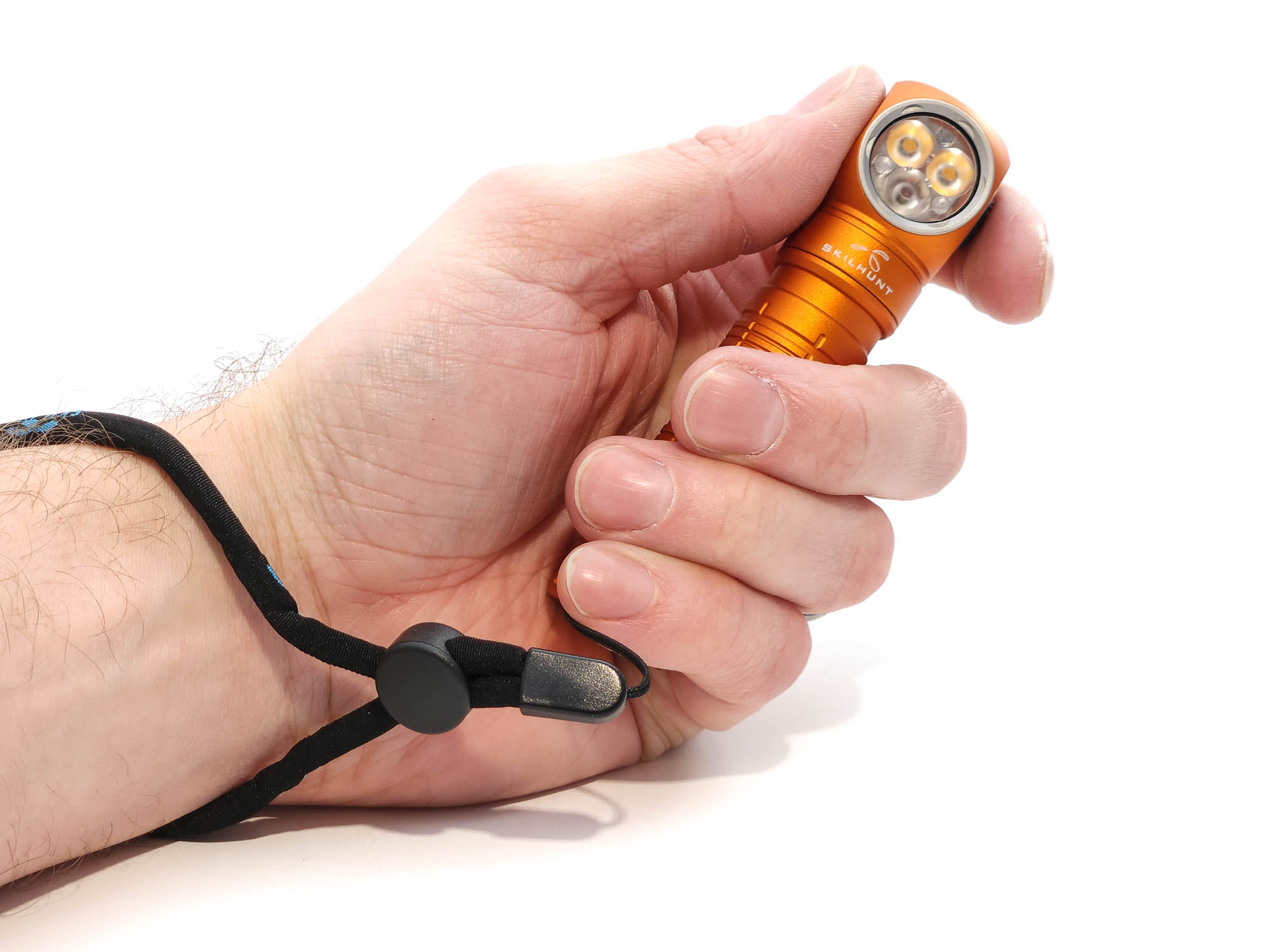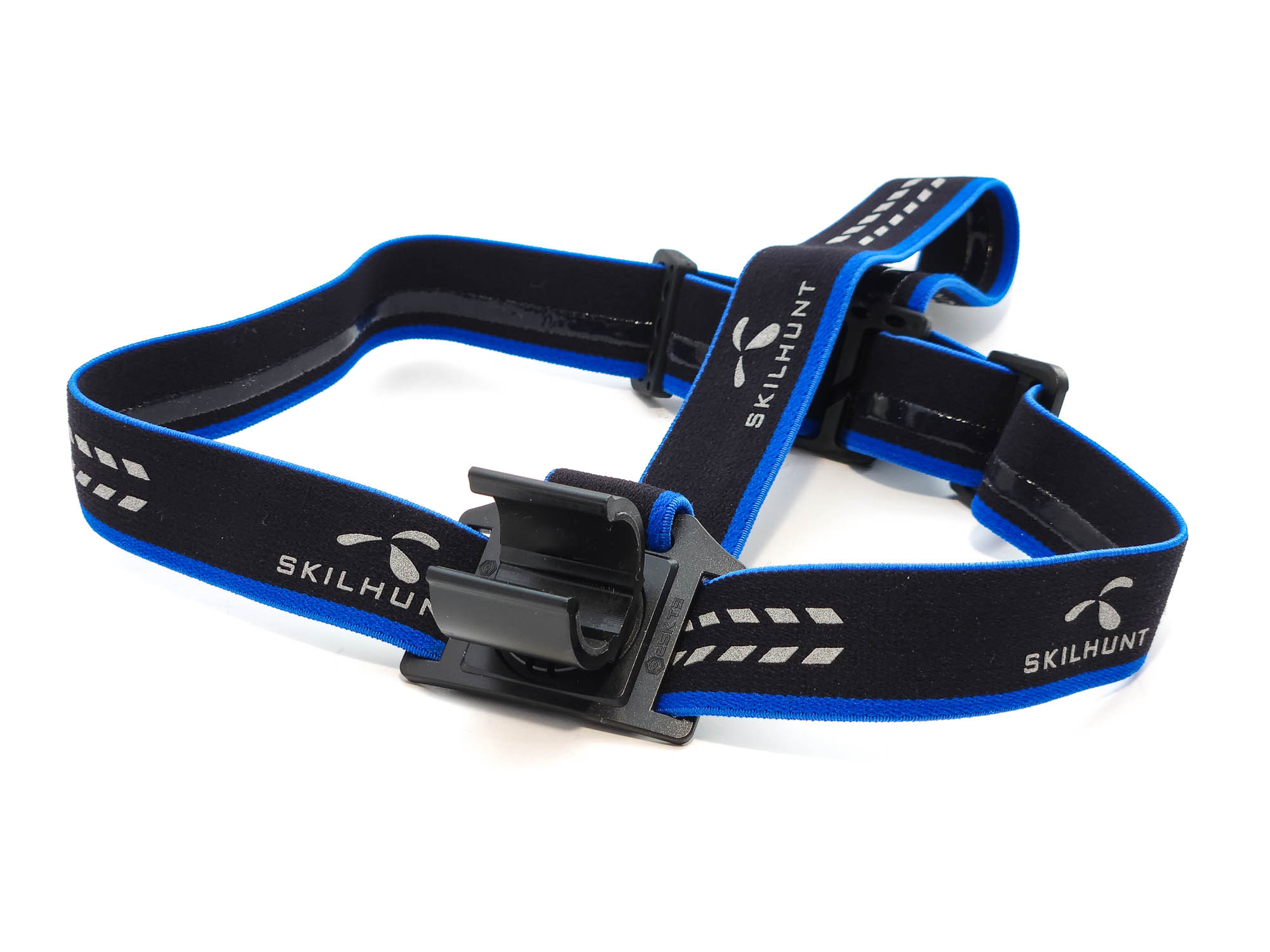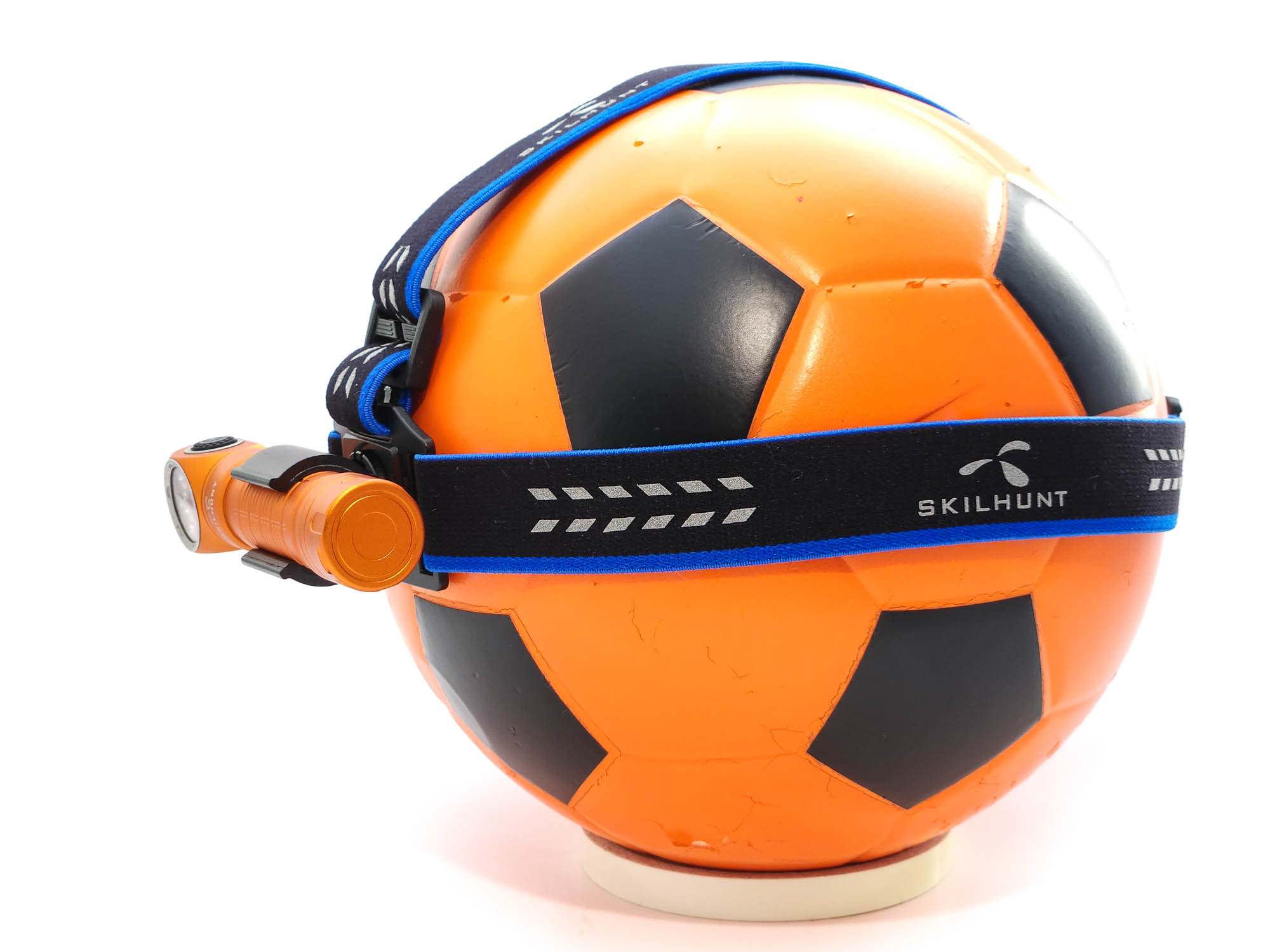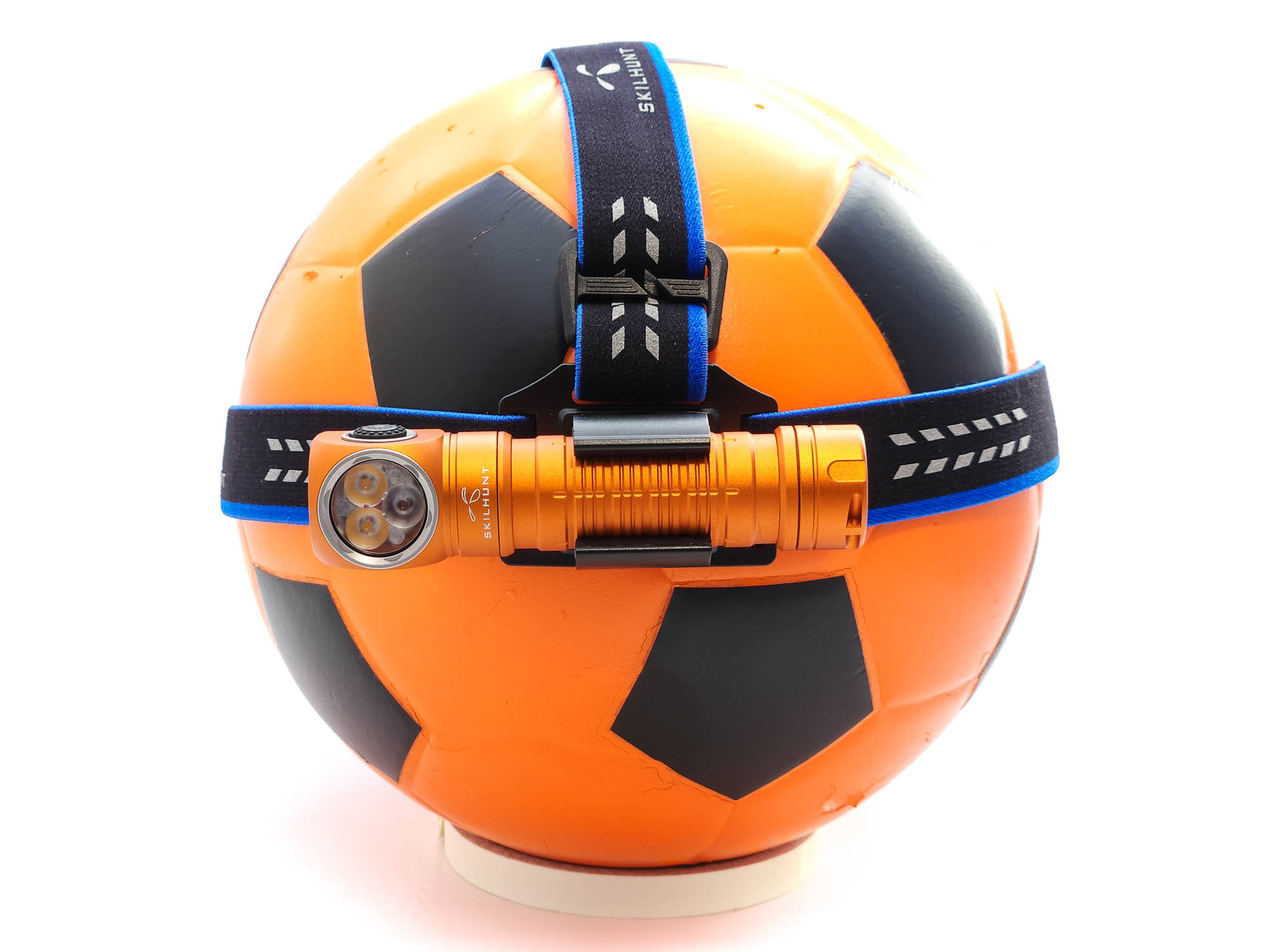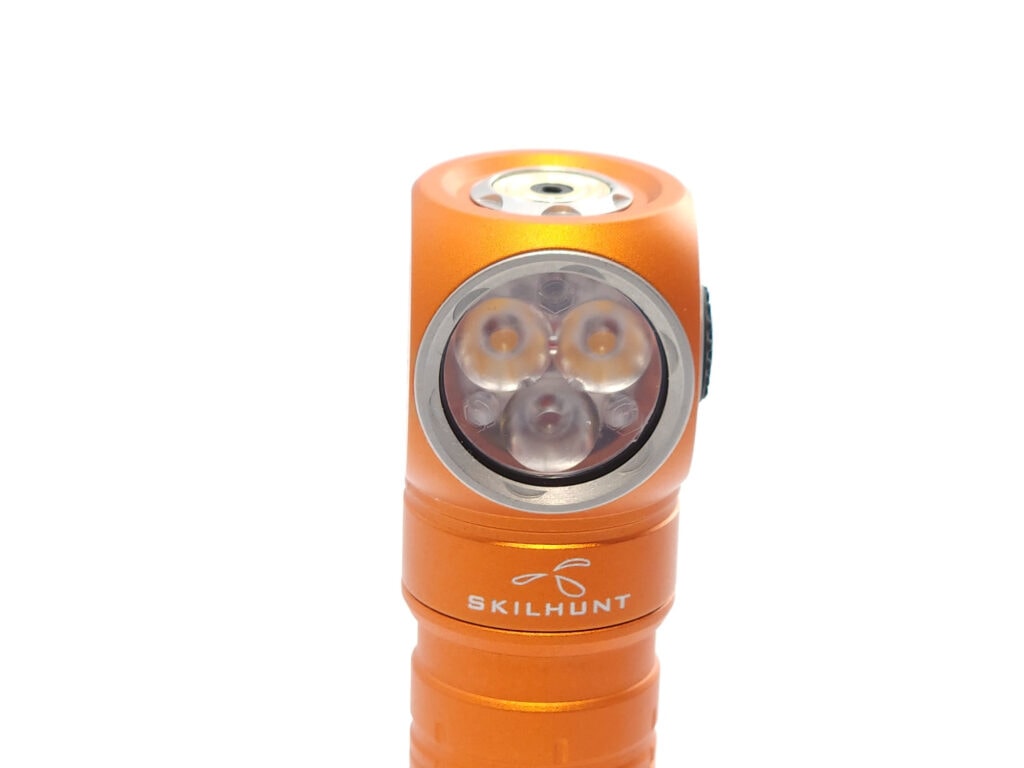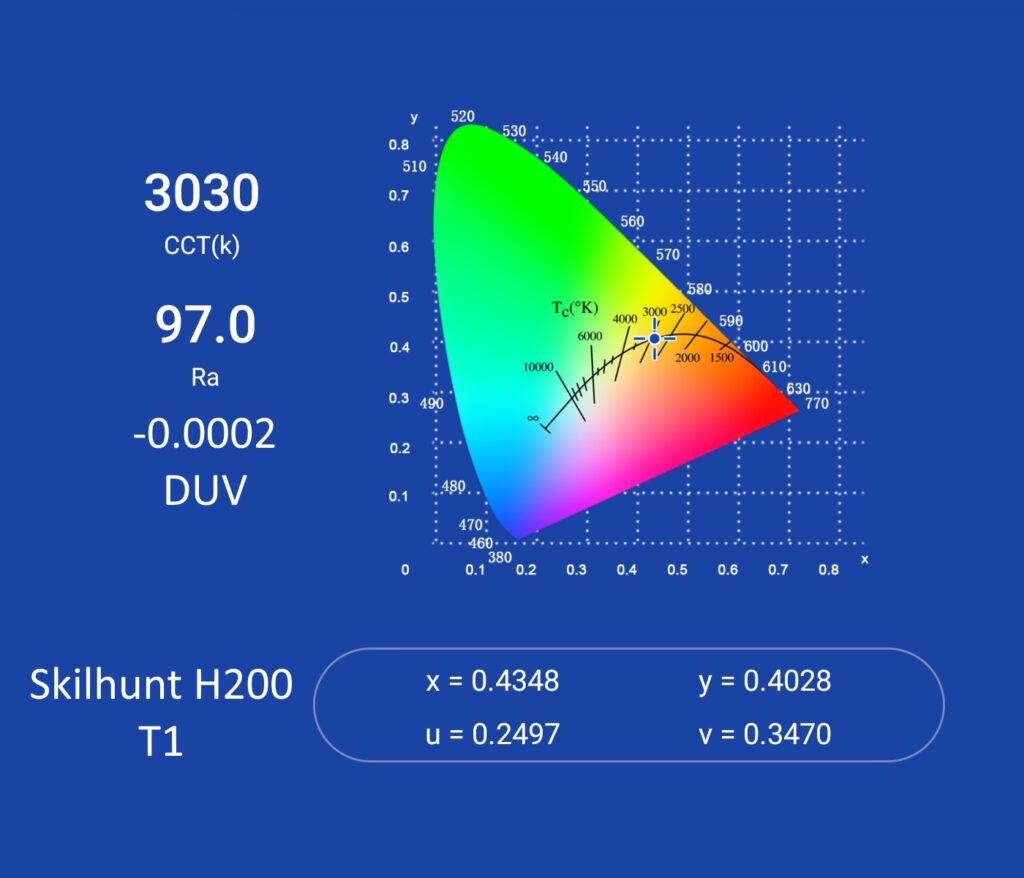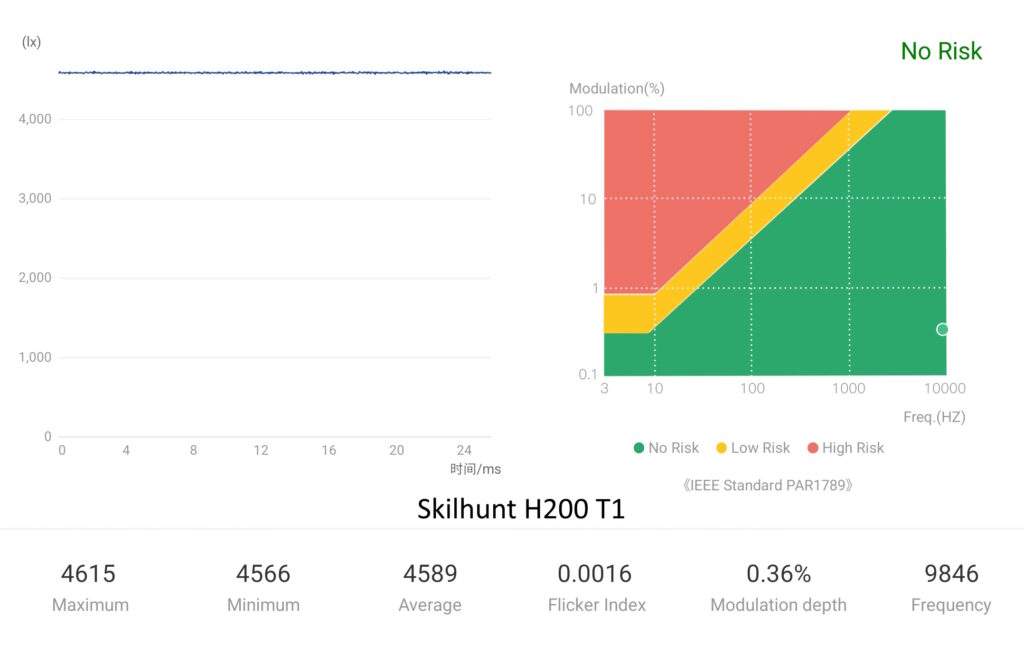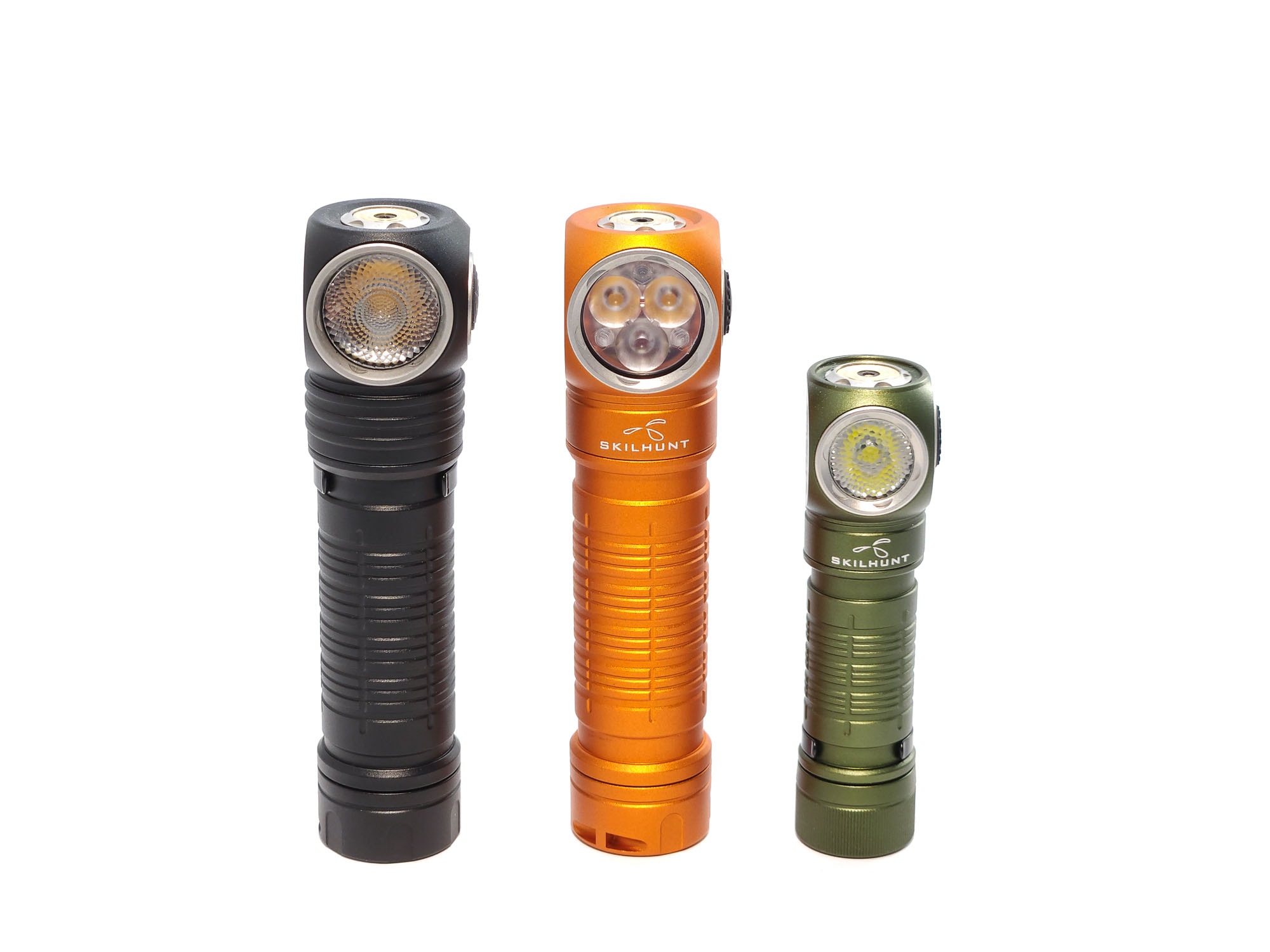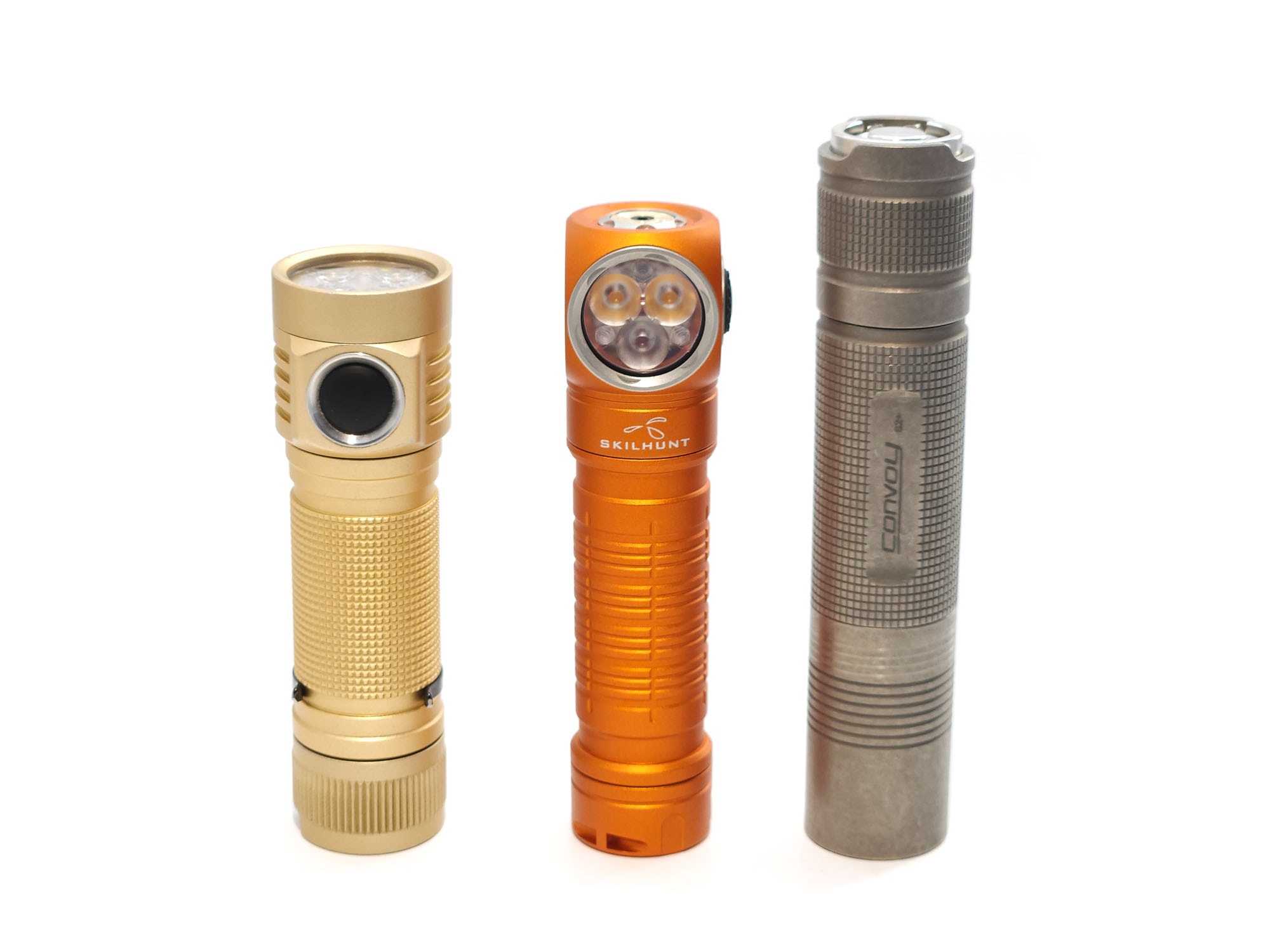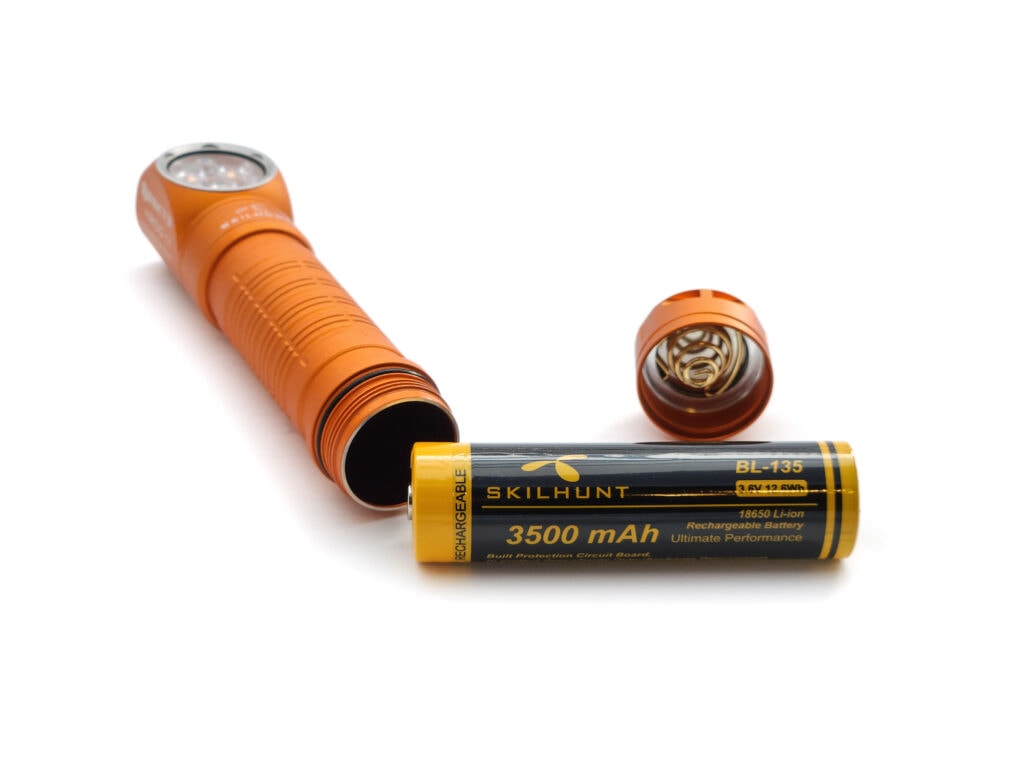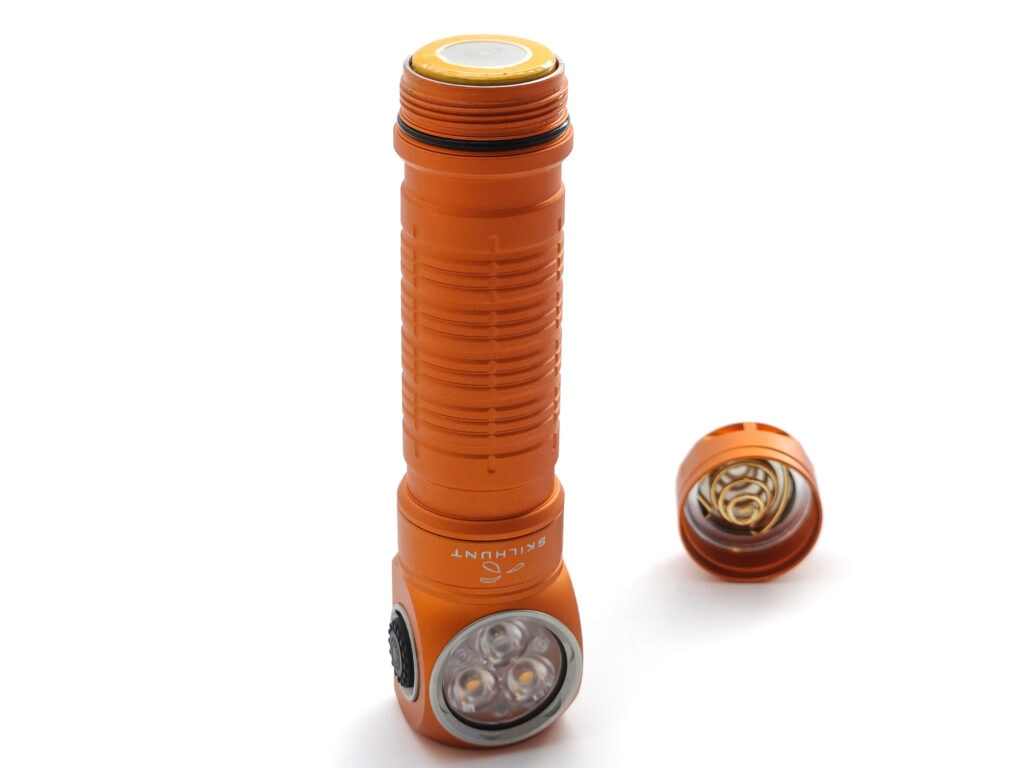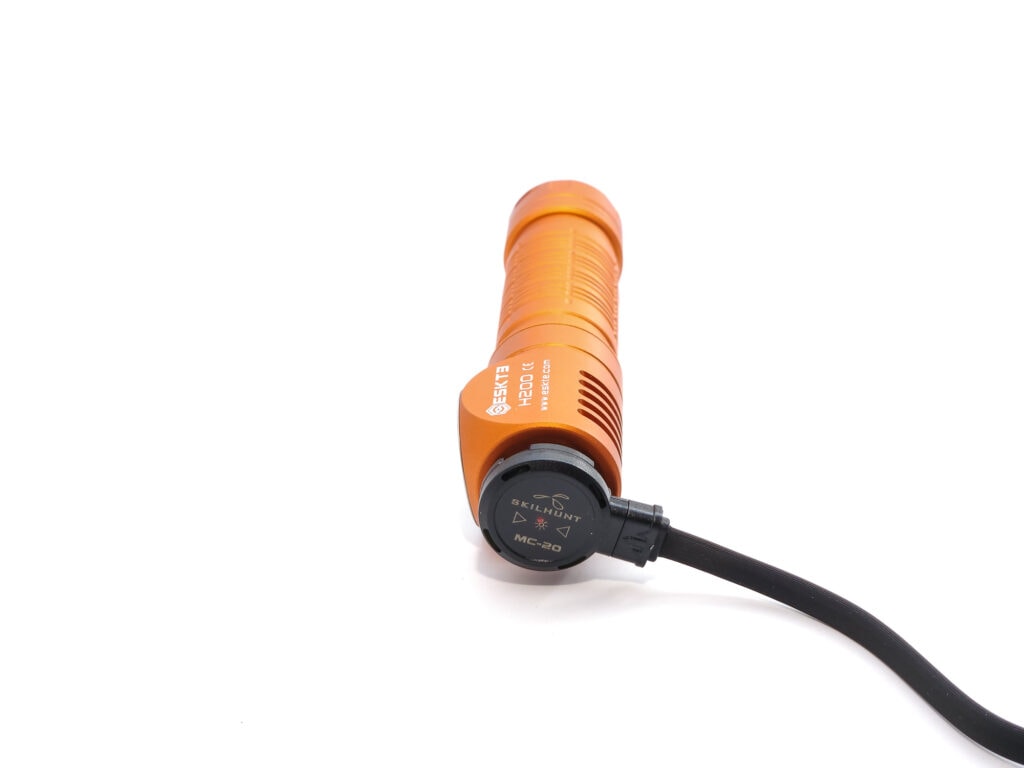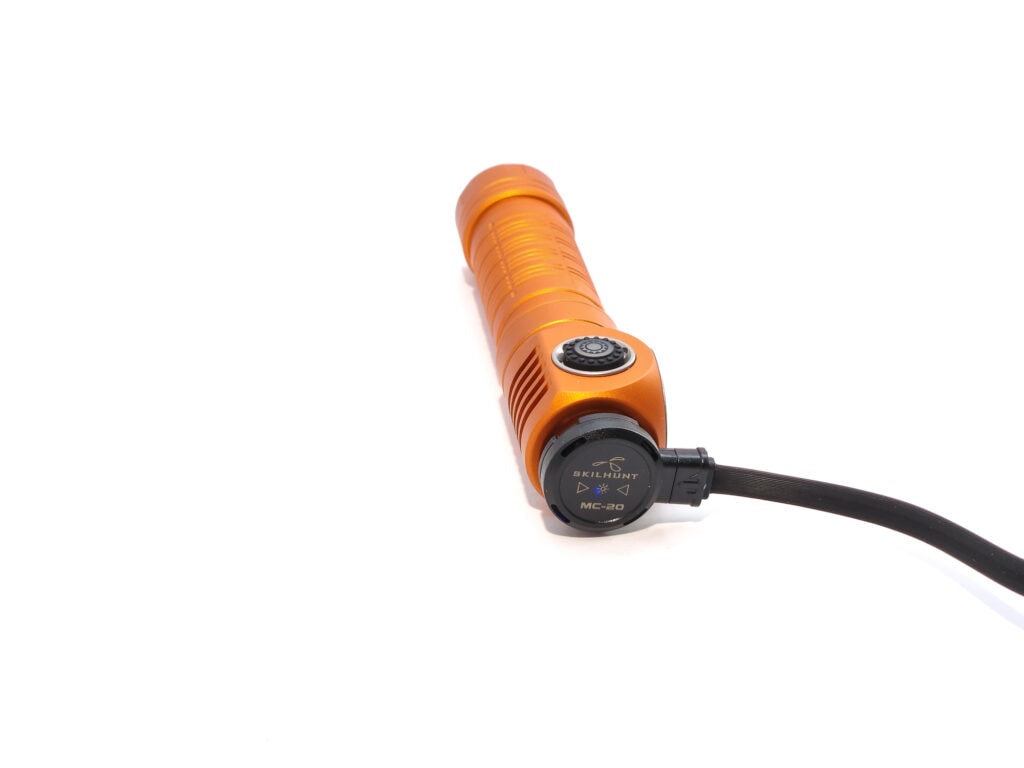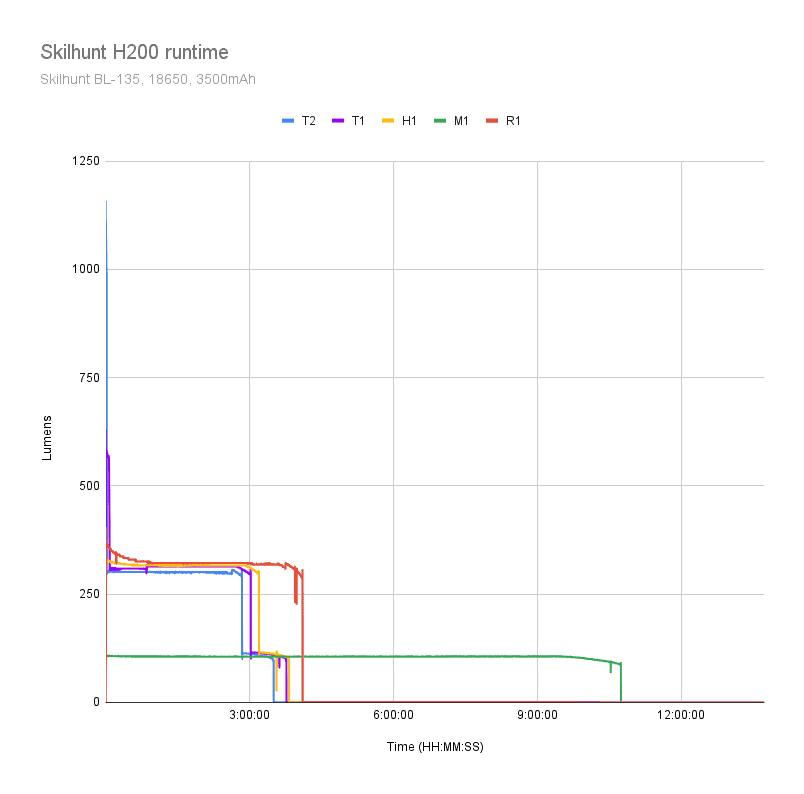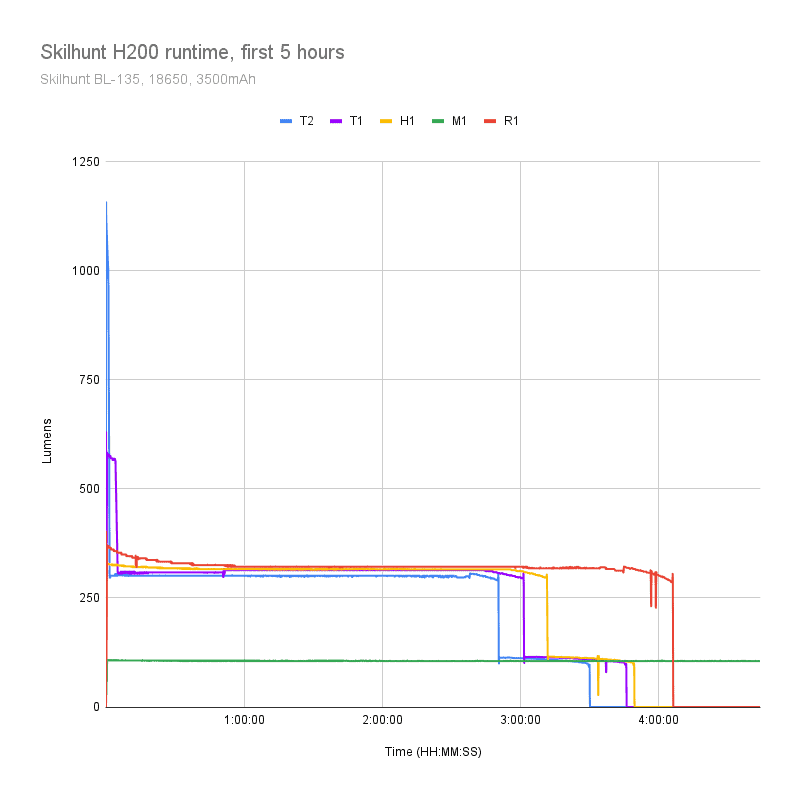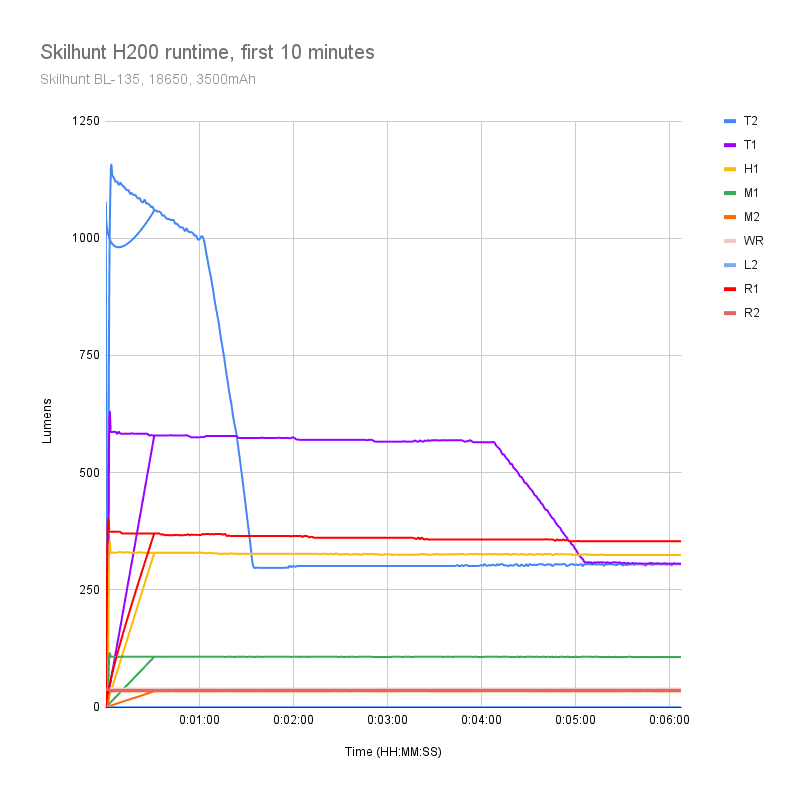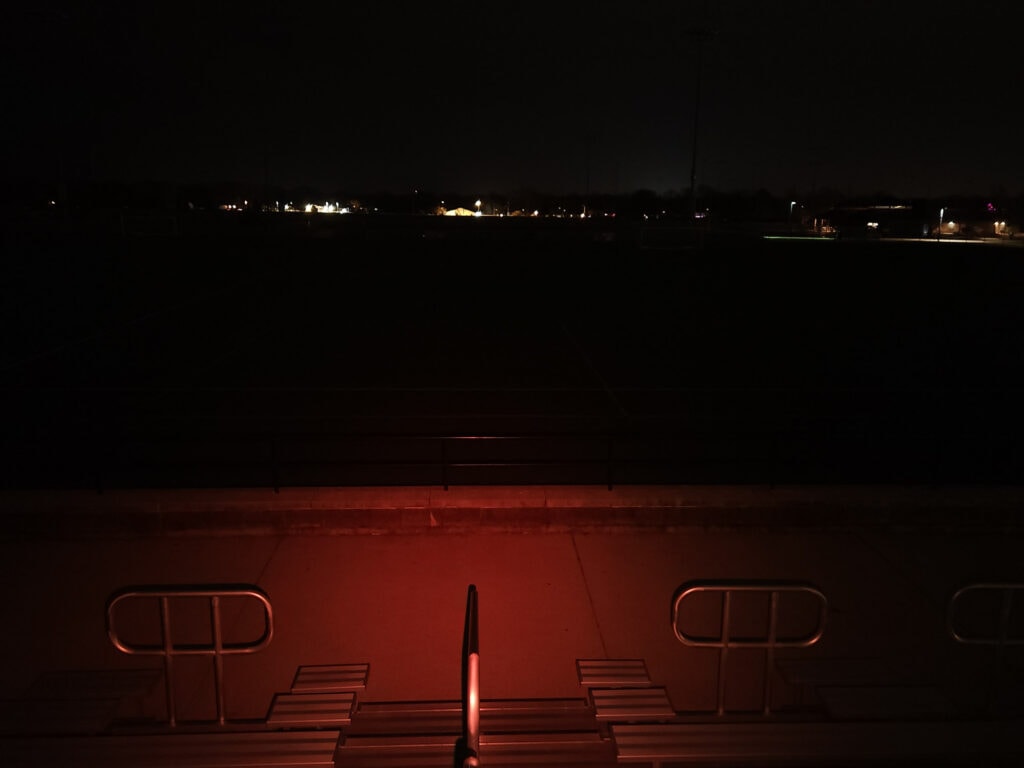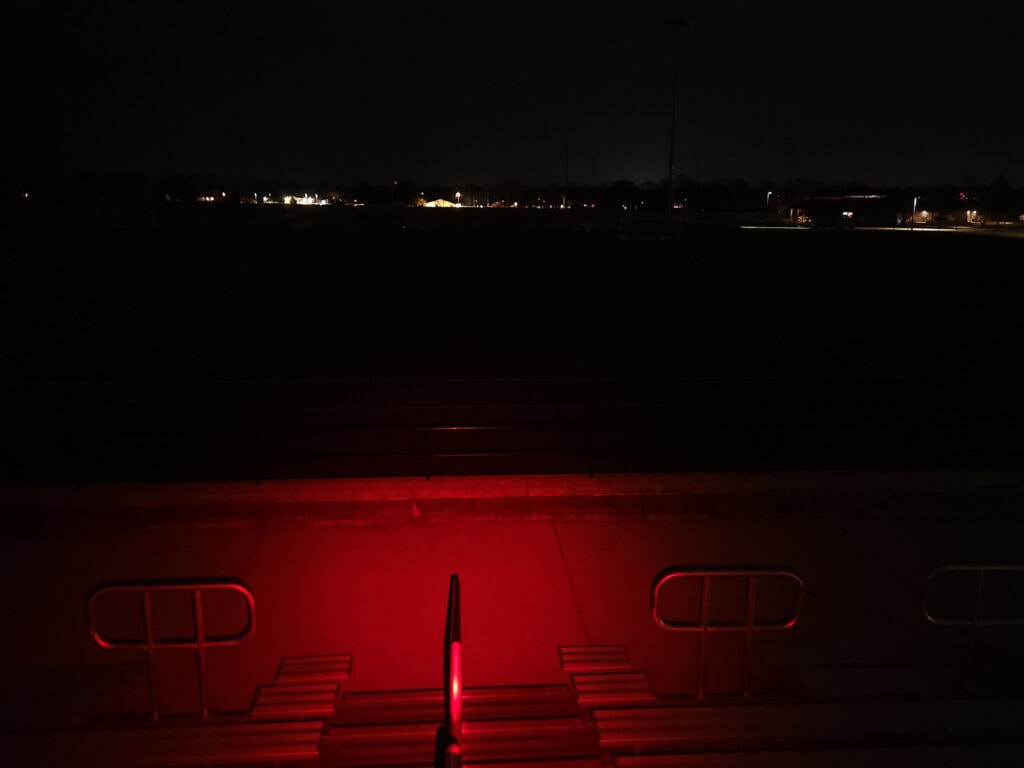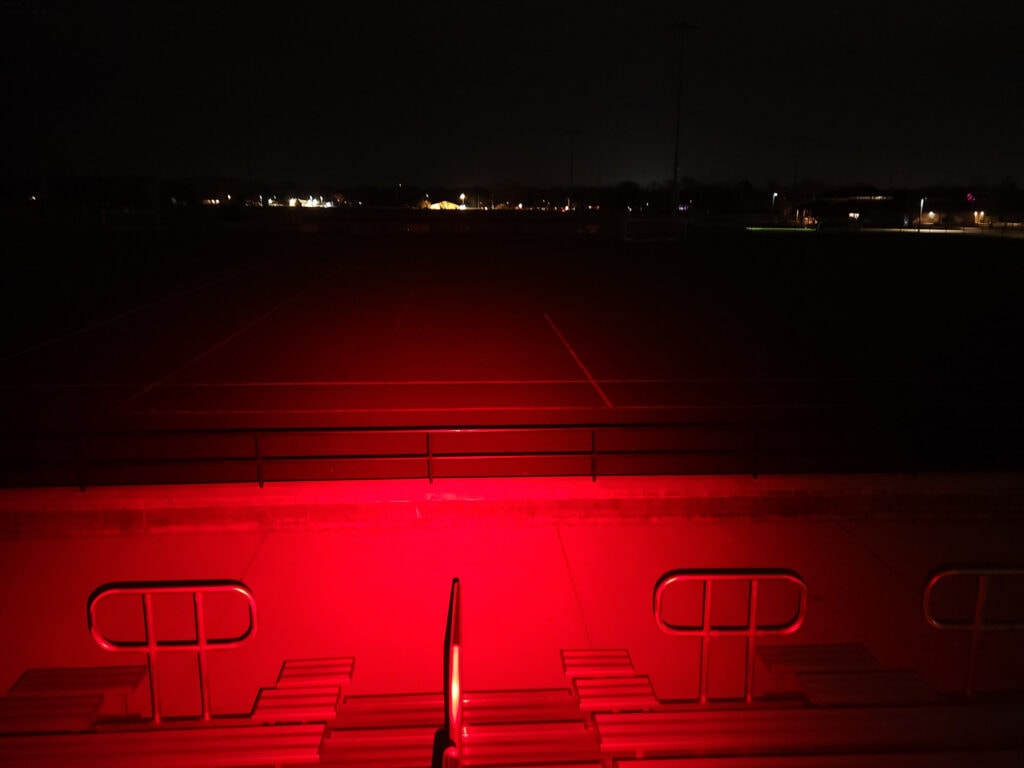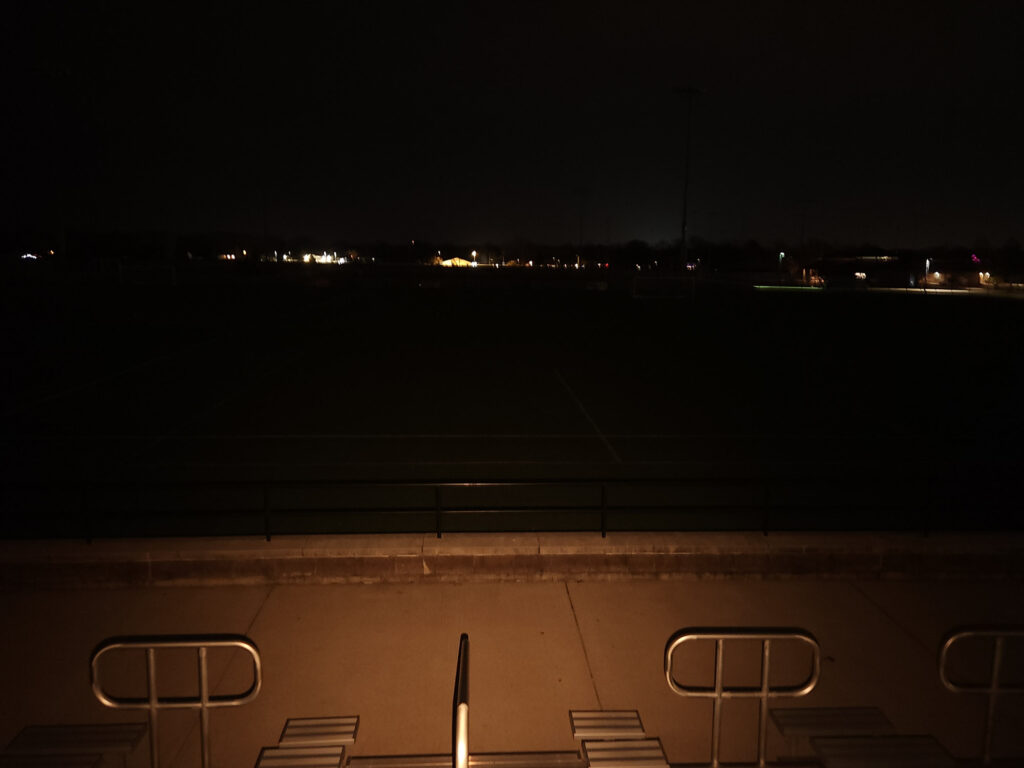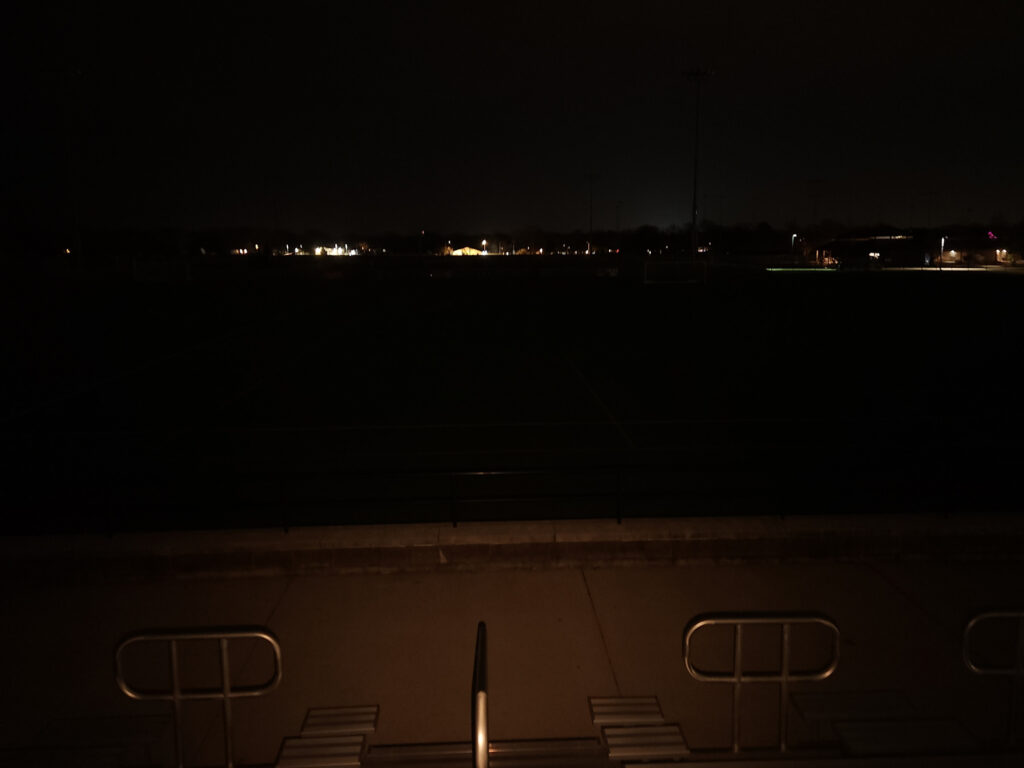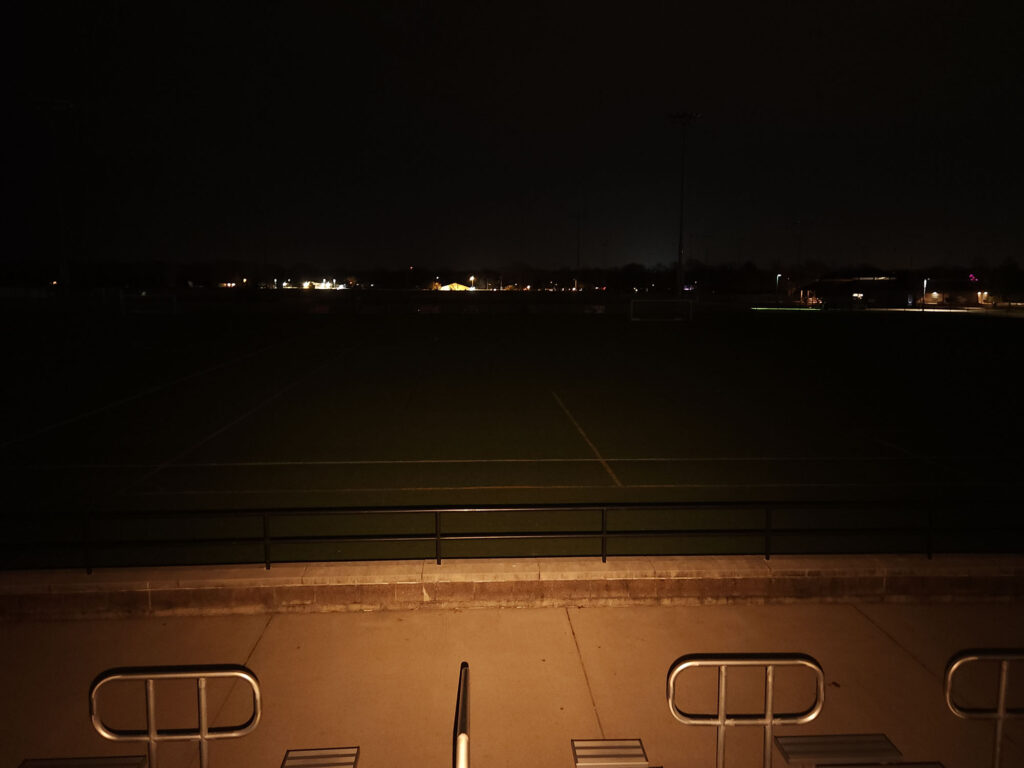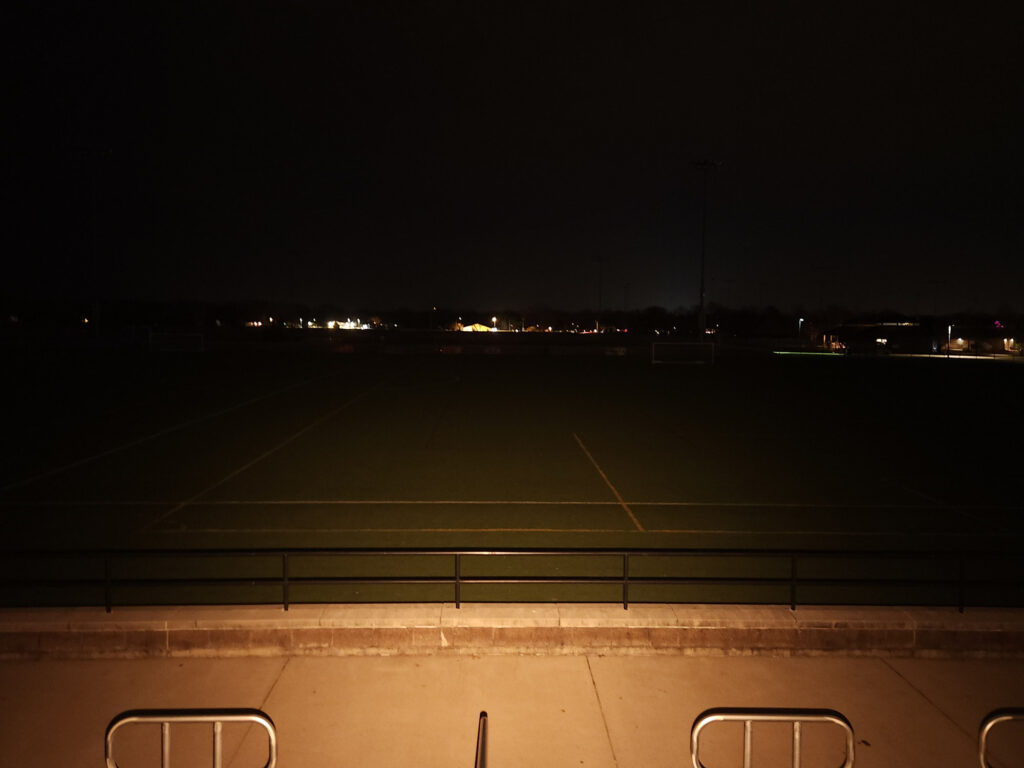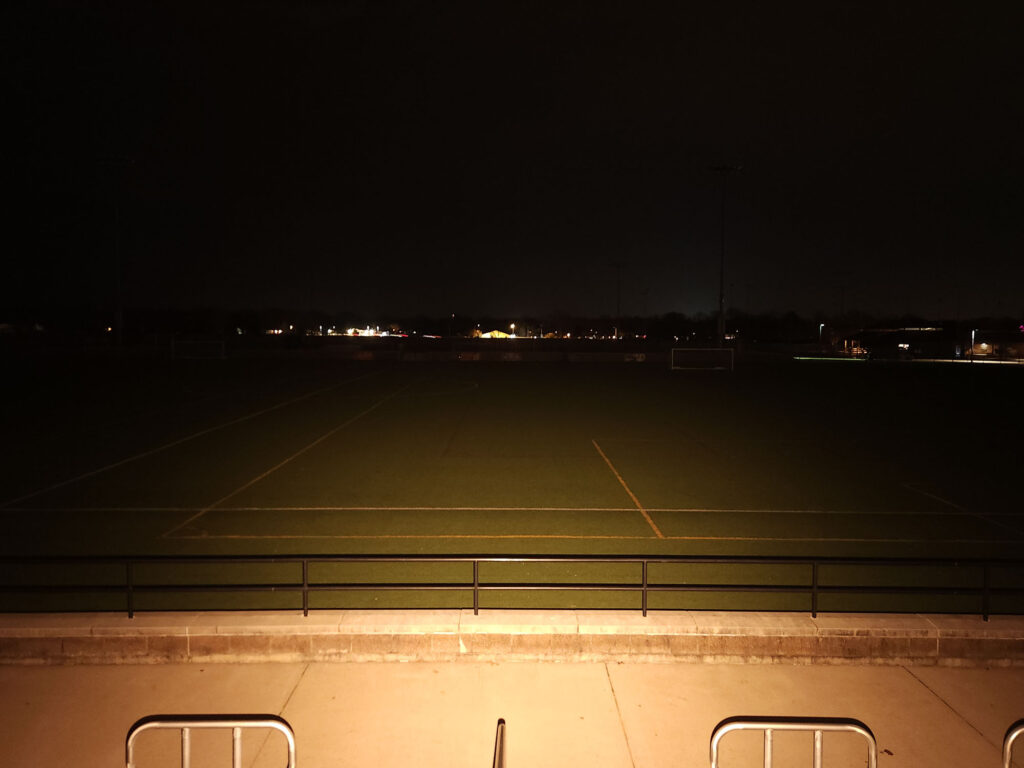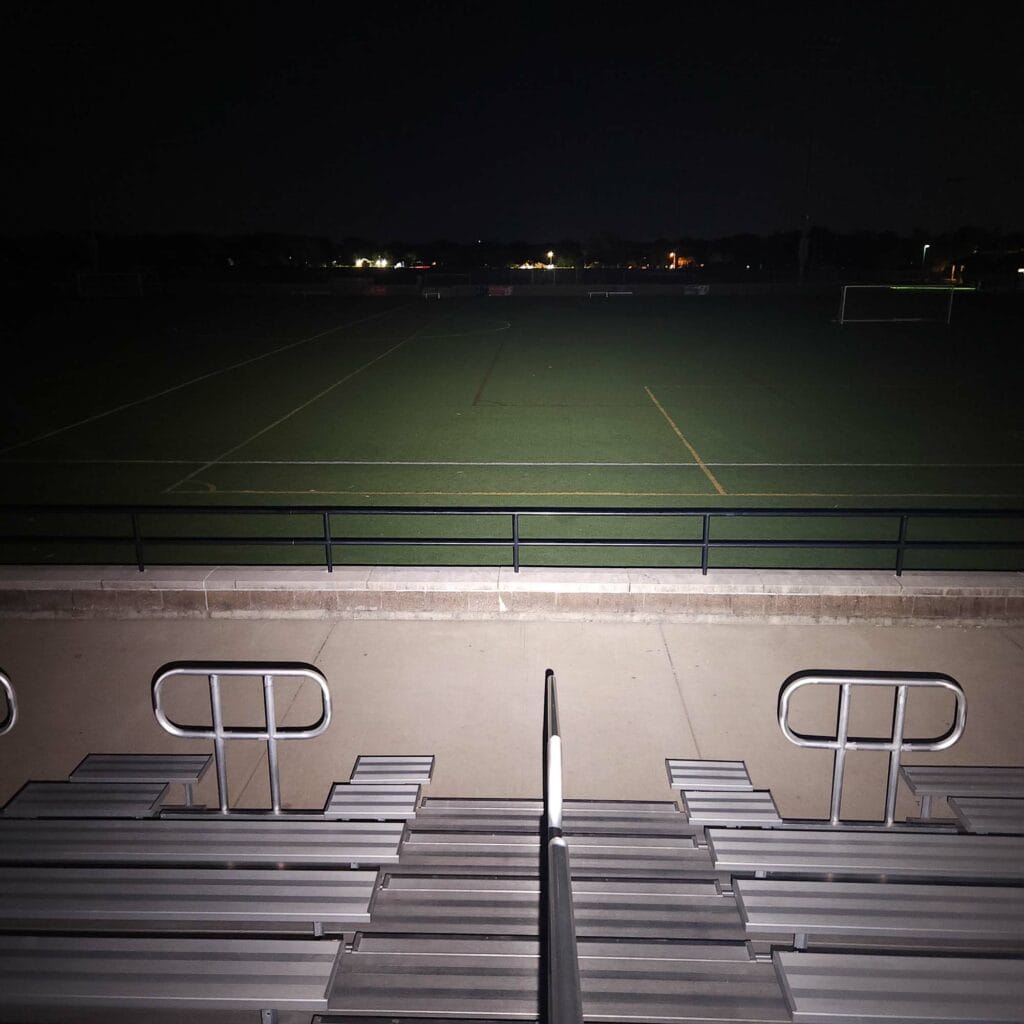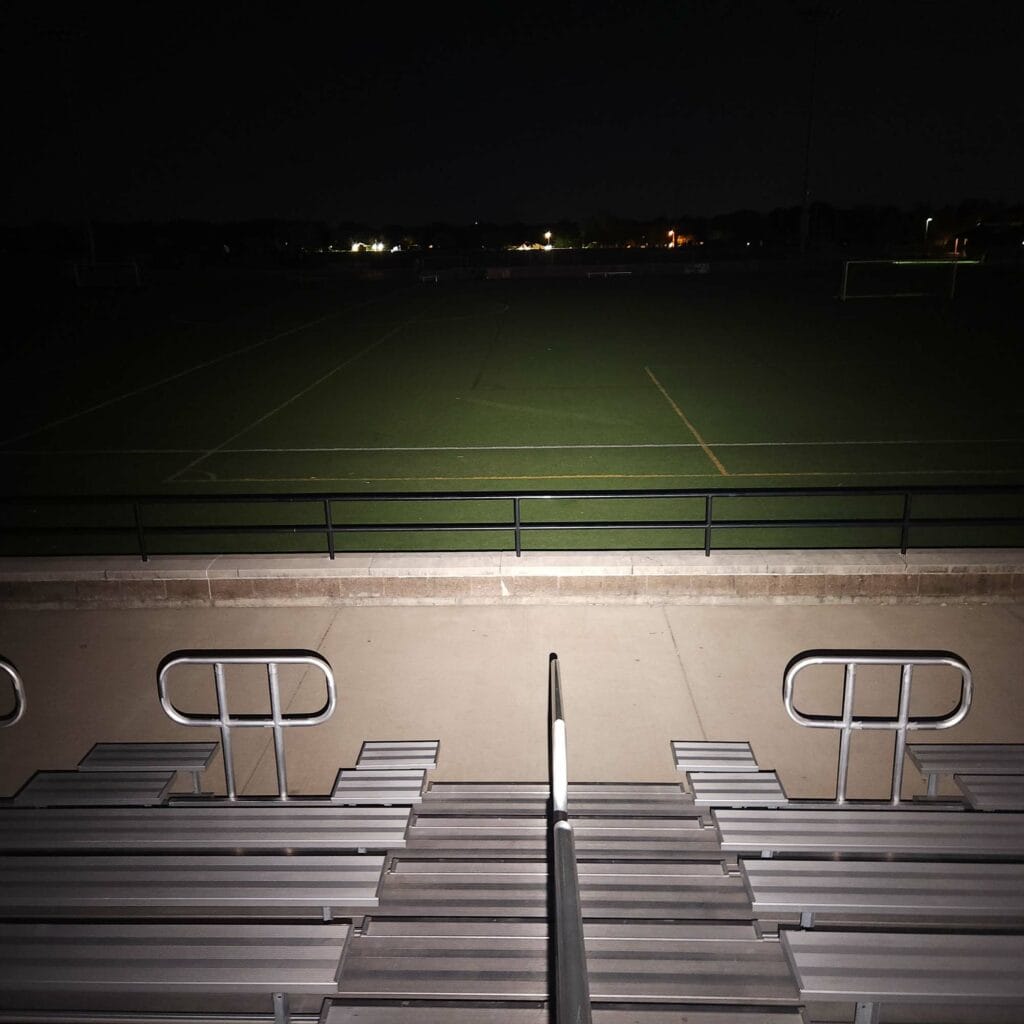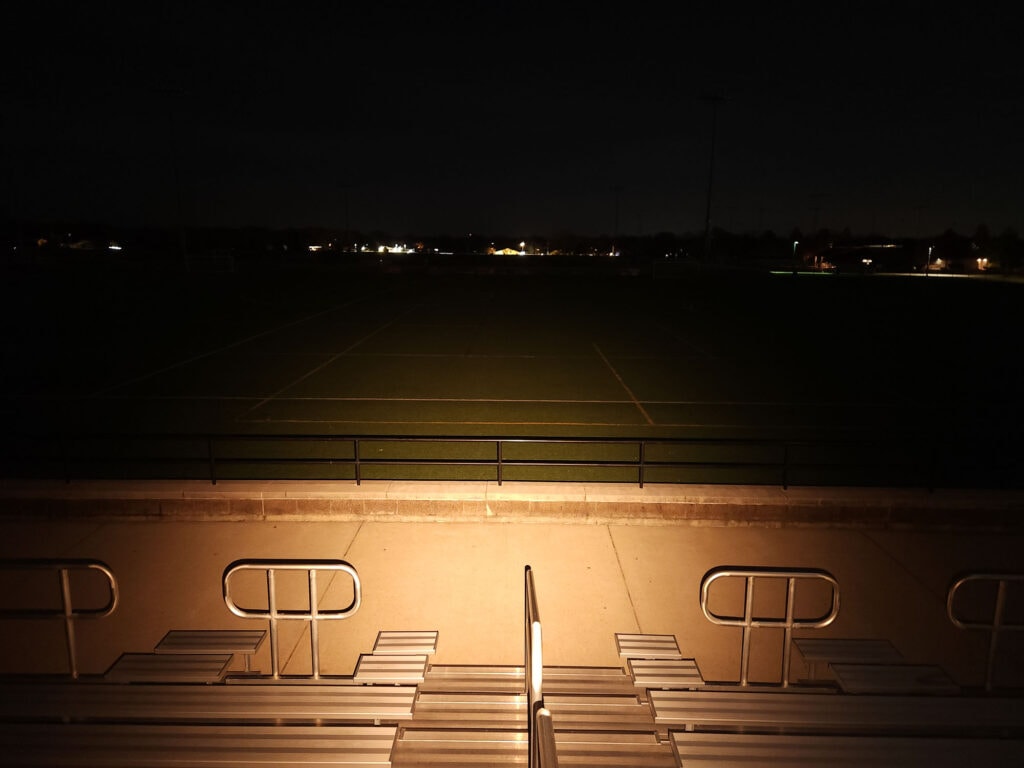1lumen selects and reviews products personally. We may earn affiliate commissions through our links, which help support our testing.
Skilhunt H200 review
Skilhunt H200 specifications
| Brand & Model | Skilhunt (ESKTƎ) H200 |
|---|---|
| Flashlight category | Headlamp / right angle/EDC/outdoors |
| LED | White: Nichia 519a 3000K (as tested) Red: Cree XP-E2 620nm |
| Max. output | 1000 lumens |
| Max. beam distance | 89 meters |
| Max. beam intensity | 2000 cd |
| Battery config. | 1*18650 |
| Onboard charging | Proprietary magnetic |
| Main modes | 9 |
| Blinkies | Strobe, SOS, Beacon |
| Waterproof | IPX8 |
| Review publication date | March 2024 |
Review intro:
Hot on the heels of the H300, Skilhunt continues their release of next-gen headlights (and rebranding to ESKTƎ) with the H200. What’s different about this one, though, is that it has 3 emitters. That by itself isn’t unusual, plenty of lights have multiple emitters, but the H200 caters to the outdoors enthusiast by using two white emitters and one red. How does that work, you ask? It’s not as complex as you think. Read on to get the whole story.
What’s in the package
Skilhunt’s packaging always looks shelf-ready, and the H200’s is no different. For the H200, there’s a clear plastic window in the front which shows off the light. It’s a little too small to see the whole light, though. I appreciate that there’s a tab you can use to pull the tray out of the box, and that the light is cradled in a molded plastic insert, while the accessories are kept together in a cardboard tray under that. It looks very professional.
Inside the box, you’ll find:
- Skilhunt H200
- Skilhunt 18650 (BL-135) loaded inside
- Clip
- Lanyard
- Headband and clip
- Plastic zip-top bag with spare o-rings and rubber disk to replace magnet
- Skilhunt MC-20 USB charging cable
- Instruction manual
Flashlight in use, Build Quality, and Warranty
Skilhunt always has high quality builds. The H200, which comes in black, green, or orange anodized aluminum, is no exception.
The head has the button on one side, and all the branding on the opposite side. On the top is the magnetic charging port, and in the rear is a set of very deep cooling fins.
The body has thick, rectangular knurling, which helps you hold onto it, though you’ll probably be using it in the headband. The head is glued to the body, so you can’t switch it around, and the only threads you can get to are on the tail. They’re nice, though, and well lubed.
The tail cap itself is rather smooth, but has a number of shallow cutouts which help with grip. The lanyard holes are also located here, and the bottom is smooth for standing up.
Skilhunt’s headband is regularly recommended for other headlamps (of the same body diameter), and may (subjectively) be the best one out there. It comes in three parts: A headband, a strap which goes over the top of your head, and a plastic clip for the light. You have to attach the top strap and clip to the headband, but it’s not too bad. The band just slips into through small cuts in the clips, then you can tighten it to your liking. Especially with the strap that goes over your head, it holds in place nicely and doesn’t put too much strain on your neck.
Another thing that’s common among Skilhunt’s headlamps is that the button is on the side of the head, if you’re standing it up, that is. When clipped into the headband, the button is on the top (or bottom, depending on how you insert it) of the light, allowing for easier activation than if it was on the top of the head. It actually works well for holding the light as well, as it places the button right at your thumb, if you’re using your right hand. In the left hand, it gets awkward to try to activate or change modes.
The clip can be attached to either end of the body tube, so you have multiple carry options with that. When on the bottom of the tube, it’s a very deep carry. On the top of the tube, quite a bit of the head sticks out, but it’s still not as much as other lights. In any case, the clip is bi-directional, so you don’t necessarily need to move it between the top and bottom of the tube if you want to change it up. You will, however, need to spin it around to the front of the light or take it off if you want to use the headband. In my experience, the black paint on the clip scratches off onto the body of the light when you’re moving the clip, but it’s mostly easy to clean off.
There’s an included lanyard which has a cinch strap with a button to keep it tight against your wrist. Skilhunt twists a small cable onto the loop end of their lanyards to make it easier to thread through the holes in the tail cap. They’re on the side of the tail cap, so you can still tail stand with the lanyard on.
Like many other Skilhunt models, the H200 has a removable magnet in the tailcap. If you take it out, there’s a small rubber disk you can put in its place to keep the spring stable. The magnet holds pretty well, so you can stick it horizontal or even upside down on something magnetic.
As the H200 is obviously designed to primarily be a headlamp, it’s best used with the headband. It’s not terribly heavy, and with the way the headband supports it, it won’t cause extra strain on your neck if you wear it for long periods of time. With the additional inclusion of a red light, this would be great for those who intend to use it more for camping and other dark outdoors activities where red light is said to preserve night vision. On that note, whether you prefer red light for nighttime use or not, you should be aware that the red levels on the H200 are listed as 12 and 125 lumens, which can be pretty high if your eyes are already adjusted to the dark. Personally, I would very much prefer to use L2 for that type of situation, since it’s only half a lumen on the 3000K model.
The H200 is covered by Skilhunt’s standard warranty. You can read the full text of it on their Service page.
To summarize:
- Free product replacement due to defect within 15 days of purchase
- Free product repair due to defect within 24 months of purchase
- Paid repair available after 24 months
- Warranty may not be honored if purchased from unauthorized dealer
- Warranty does not cover normal wear or non-defect damage
LED, Lens, Bezel, Beam, and Reflector
Here’s where the H200 differentiates itself from other Skilhunt headlights: It’s the first Skilhunt headlight to use multiple emitters. It’s not, however, their first multi-color headlight. That honor goes to the H03RC, though multiple colors in that light was achieved with a quad die with 4 different colored emitter pads. The H03RC has been discontinued, so the H200 is filling a long standing hole in their lineup.
Like with many of Skilhunt’s offerings, you can choose from a new Cree XP-G4 6500K emitter, or the Nichia 519a in either 3000K or 4500K. My sample is the 3000K model, so my measurements will be lower than either of the other two emitters, so keep that in mind for later.
In addition to the white emitters, the H200 uses a Cree XP-E2 620nm red emitter.
All three of these emitters are behind a frosted TIR optic for more floodiness, which in turn appears to be behind an anti-reflective glass lens, though it is not mentioned on the product page. There’s a little detail that I like which is that that they have stamped the new ESKTƎ logo on the TIR in the spaces between the emitters.
The bezel on the H200 screws in, so you could access the emitter to swap it if you wanted, but with three emitter options, you can probably just buy one with the type of emitter you need.
The white channel on the H200 is very floody due to the frosted TIR and gives you a very even beam without much of a hotspot. The red channel has more of a hotspot to it since there’s only one emitter, even though it’s behind the same TIR. When you put them together in the WR (white/red) mode, it makes a sort of a lopsided pink beam since the red overpowers the white. This might be better for ceiling bouncing rather than direct illumination.
It’s also fun to note that the SOS and beacon modes use the red emitter instead of white.
Spectral measurements:
I used an Opple Light Master Pro to measure the flashlight at 1 meter.
| Mode: | CCT: | CRI Ra: | duv |
|---|---|---|---|
| T1 | 3030 K | 97.0 | -0.0002 |
Dimensions and its competition
Dimensions:
| Skilhunt H200 | Millimeters | Inches |
|---|---|---|
| Length | 104 mm | 4.1 in |
| Head diameter | 30 mm | 1.2 in |
| Body diameter | 22 mm | 0.9 in |
Dimensions are rounded to the nearest millimeter and the nearest tenth of an Inch.
Weight:
| Skilhunt H200 | Weight in grams | Weight in oz |
|---|---|---|
| Without battery: | 58 g | 2.0 oz |
| With battery | 108 g | 3.8 oz |
Weight is rounded to the nearest gram and tenth of an Oz.
Flashlight size comparison with its competition:
Group 1: Skilhunt H300, Skilhunt H200, Skilhunt H150
Group 2: Emisar D4V2, Skilhunt H200, Convoy S2+
Skilhunt H200 UI: User Interface and Driver
The H200 uses a variation on Skilhunt’s standard UI in order to be able to manipulate both the red and white emitters with a single button. It’s actually not all that much more complicated than their standard UI; basically, the red channel is added to the low grouping.
Available modes:
- L2, WR (white/red), R2 (red), R1 (red), M2, M1, H1, T2, T1
Available blinky modes:
- Strobe (white), SOS (red), beacon (red)
From OFF:
- Press and hold: Memorized low/red group: L2, WR, R2, R1
- Single click: Memorized main group: M2, M1, or H1
- Double click: Memorized turbo group: T2 or T1
- 3 clicks: Memorized strobe group
- 4 clicks: Lockout
From ON:
- Press and hold: Cycle next level within the same group (except strobe)
- 1 click: Off
- Double click: Memorized turbo level (except from low group)
- In the low group: Toggle between L2 to R1 or WR to R2
- 3 clicks: Memorized strobe mode
Mode memory:
- Each of the groups retains its level
Shortcuts:
- To Low/Red: Hold from off
- To Turbo: Double-click from off or regular group
- To Strobe: Triple-click from off or regular group
Low voltage warning:
- When the battery is getting low, the indicator light on the switch blinks red, and the emitter will blink twice every two seconds
Strobe/blinkies
- Triple-click to get into strobe group
- Double click to cycle through strobes
- Strobes
- Strobe – Uses only the white emitters and changes frequency
- SOS – Uses only the red emitter
- Beacon – Uses only the red emitter; 1Hz
Lock-out mode:
- Electronic lockout is possible with 4 clicks from off
- When in electronic lockout, you can hold for momentary moonlight (L2)
- Physical lockout is also possible by unscrewing the tail cap
- Double-click in lockout to enable or disable the locator beacon in the indicator light
PWM
- Not visible to me by eye or on my phone’s camera.
Skilhunt H200 Charging and batteries
The H200 came with Skilhunt’s BL-135, a protected, button top, 69mm by 18.6mm, 18650 battery, which has 3500mAh capacity and is capable of 8A continuous discharge and 17A burst.
Skilhunt includes their MC-20 with the H200. This 2A magnetic charger sticks to the port on the top of the head and includes a tiny indicator light which is red while charging and turns blue when complete.
Of course, this is a proprietary connector, which some people dislike, but it works fine. Even better would be if you had multiple Skilhunt lights, since you get a charger with each and you’ll have spares. If you lose your charger or it breaks, you’ll either have to buy another cable or charge your batteries externally.
The H200 has low voltage protection on the driver, and it kicks in around 2.9V. Charging took on average 3 hours, which seems a bit long for 2A and a 3500mAh battery, and terminated around 4.13V. Incidentally, you can use the light on any mode while charging. Plugged in without the battery, you can use any mode but T2.
When I did a 250mA capacity test with my Vapcell S4+ charger, it finished at 3467mAh. Short of the BL-135’s specs, but not by too much.
| Charge type | Fits | No fit | Charge time |
|---|---|---|---|
| Flashlight with onboard USB-C | All 18650 sizes | Exceptionally long 18650s | 3-3.5 hours |
Performance test
Lumen measurements
How Lumens are Measured: Understanding ANSI FL1 Standards How Lumens are Measured: Understanding ANSI FL1 Standards: The ANSI FL1 standards specify that output in lumens should be measured 30 seconds after turning on, as this is the standardized time for measuring brightness according to the industry standard. This is why we focus on this part in our measurements. The ANSI FL1 standards require an ambient temperature of 22 ± 3°C. We record the ambient the ambient temperature to identify potential reasons for any observed discrepancies.To obtain these numbers, I used a very rudimentary integrated shoebox and ceilingbounce on my Samsung Galaxy S10. Measurements have been calibrated using a standardized calibration light provided by 1Lumen.
The red modes really stuck out for being so much higher than they’re supposed to be. Honestly, I don’t know if that’s really accurate, or if red light is detected differently than white light, so please take that with a grain of salt.
The rest of the modes all eked out above their specifications, too, but not like the red modes. While Skilhunt is very good at reporting accuracy in their specs, keep in mind that I am running an amateur setup here. It’s still very nice to see them so close to spec!
| Mode | Amps at start | Specified | Turn on | 30 sec. | 10 min. |
|---|---|---|---|---|---|
| R2 | 0.07 | 12 | 36 | 36 | 36 |
| R1 | 0.83 | 125 | 375 | 370 | 346 |
| L2 | 0.00 | 0.5 | 0 | 0 | 0 |
| WR | 0.11 | 28 | 40 | 40 | 39 |
| M2 | 0.10 | 30 | 33 | 33 | 34 |
| M1 | 0.30 | 100 | 107 | 107 | 107 |
| H1 | 0.96 | 300/100 | 330 | 329 | 323 |
| T2 | 2.20 | 520/300/100 | 587 | 579 | 309 |
| T1 | 3.70 | 1000/300/100 | 1059 | 859 | 303 |
| Turbo at 3.6V | 2.50 | – | 903 | 861 | 269 |
Ambient temperature during testing:
- 21 °C
Parasitic drain:
- 0.00 mA
Amps were measured with a Klein Tools MM300 digital multimeter to the best of my ability.
Skilhunt H200 Battery Life: Runtime graphs
How Runtimes are Measured: Understanding ANSI FL1 Standards About ANSI FL1 runtime standards: The runtime is measured until the light drops to 10% of its initial output (30 seconds after turning on). This does not mean that the flashlight is not usable anymore. The last column shows how long the light actually works till it shuts off. If there is a + symbol, it means that the test was stopped at that particular point, but the light was actually still running. This happens on certain occasions, with certain drivers, firmware, or batteries.To obtain these numbers, I used a very rudimentary integrated shoebox and ceilingbounce on my Samsung Galaxy S10. Measurements have been calibrated using a standardized calibration light provided by 1Lumen.
While a couple of modes fall just short of their ANSI runtime (but not by much), the rest end up about 10-15 minutes longer! Note that the longer modes were not tested due to the time it would take. These are some pretty good numbers, and look how well regulated the output is! Another hallmark of Skilhunt lights.
| Mode | Specified | Runtime (ANSI FL1) | Time till shut off |
|---|---|---|---|
| R2 | 40h | – | – |
| R1 | 4h 10min | 4h 06min | 4h 06min |
| L2 | – | – | – |
| WR | 28h | – | – |
| M2 | 30h | – | – |
| M1 | 10h 30min | 10h 45min | 10h 45min |
| H1 | 3h 35min | 3h 49min | 3h 49min |
| T2 | 3h 30min | 3h 46min | 3h 46min |
| T1 | 3h 31 min | 3h 17min | 3h 30min |
Peak beam intensity and beam distance measurements
About Peak beam intensity: Understanding ANSI FL1 Standards About peak beam intensity The calculated value of distance in meters at which the flashlight produces a light intensity of 0.25 lux. (0.25 lux is about the brightness of a full moon shining on an object). This means that the intensity has decreased so much, it becomes difficult to see darker objects, or objects that don’t reflect light. The columns ‘Meters’ and ‘Yards’ use rounded numbers.The numbers for candela were obtained with an Extech SDL400 luxmeter at 5 and 15 meters, then averaged (except for L2, which was only measured at 1m). T1 hits pretty close to the advertised mark!
I’d put a slight asterisk by the candela on red settings due to their extremely high lumen readings. I’m not exactly sure how, if at all, red light causes different measurements than white light.
| Mode | Specified | Candela measured | Meters | Yards |
|---|---|---|---|---|
| R2 | – | 75 cd | 17 m | 19 yd |
| R1 | 800 cd | 575 cd | 48 m | 52 yd |
| L2 | – | 1 cd | 0 m | 0 yd |
| WR | – | 75 cd | 17 m | 19 yd |
| M2 | – | 50 cd | 14 m | 15 yd |
| M1 | – | 175 cd | 26 m | 28 yd |
| H1 | 525 cd | 46 m | 50 yd | |
| T2 | – | 950 cd | 62 m | 68 yd |
| T1 | 2000 cd | 1950 cd | 88 m | 96 yd |
Ambient temperature:
- 21 °C
Beamshots
These were taken with a Samsung Galaxy S22+ using pro mode and the following settings:
- WB 5000K
- ISO 200
- Speed 0.5
Distance to the other end of the playing field is 100 meters.
Beamshots of the following flashlights compared:
- Skilhunt H200
- Skilhunt H300
- Skilhunt H150
Please note that the following beamshots are mainly intended to showcase the beam pattern and beam quality, rather than overall performance. These images are typically taken directly after activation, and in different seasons or weather conditions, and therefore do not fully represent its overall performance. For accurate performance metrics, such as output, beam distance, and runtimes, you need to look at the performance section of this review.
Disclaimer: This flashlight was sent to us for review at no cost by Skilhunt. We have not been paid to review, nor have we been holding back on problems or defects.
Final Verdict
Pros
- White and red in one!
- Complete package with optional battery and onboard charging
- High CRI and good tint
- Good sustained output thanks to regulation
- Button placement makes for easy activation when used as headlamp
- High quality headband
Cons
- Red output is fairly high in complete darkness
- White+red is unbalanced
- Proprietary charger
- Definitely for flood; very little throw
Explanation on star ratings:
1: Avoid: a match would be a better choice – 2: Poor: significant defect or issues; almost unusable – 3: Average: some defects or issues; but still usable 4: Good: recommended (minor issues) – 5: Great: highly recommended
5 stars: ★★★★★
While our star rating provides a reliable indicator, we encourage you to read the full review to make an informed decision based on your own needs and preferences.
Skilhunt has hit another one out of the park with their H200. It’s hard to find faults with Skilhunt to begin with, and the inclusion of red in the package only sweetens the deal. Really, my only complaint is that there should be another L2-like red level in addition to the existing two red levels. If they could swap out the awkward white+red for a red L2, it might be perfect, though this is just the subjective opinion of someone who prefers white light over red. Keep in mind, too, that this is definitely a flooder and not a thrower.
If you don’t mind Skilhunt (rebranding to ESKTƎ) having a proprietary magnetic charger, or better yet, if you’ve already bought into the Skilhunt ecosystem, then I don’t see any reason why not to highly suggest the H200 with five whole stars.
Buy your Skilhunt H200 with a discount
Get 6% discount at Skilhunt by using the following discount code: blf06
1lumen selects and reviews products personally. We may earn affiliate commissions through our links, which help support our testing.
